




The University of Szeged offers the opportunity for the most talented and diligent to develop, while Alfred Nobel has given humanity the opportunity to recognize the best.
The Nobel Prize of Katalin Karikó marks a chapter in the history of biochemical research initiated at the University of Szeged, following the vision of Kuno Klebelsberg. At the end of the 1920s, shortly after the relocation of the University of Cluj to Szeged, Kuno Klebelsberg initiated the establishment of a world-class biochemical and life sciences research centre.To accomplish this, he invited Albert Szent-Györgyi back to Hungary, and the vision was confirmed within ten years: in 1937, Szent-Györgyi received the Nobel Prize for investigating the processes of biological combustion and discovering vitamin C. The impact of the Nobel Prize and Szent-Györgyi can still be felt today, as it led to the establishment of research schools, which developed and became extremely important in their own right. It would be too long to list how many similar scientific schools have developed from Albert Szent-Györgyi’s research model, not only in the field of medicine but also in other life sciences. The opening of the Biological Research Centre of Szeged can be considered the result of these research workshops.
Katalin Karikó herself linked her Nobel Prize to the University of Szeged and the Biological Research Centre of Szeged; during her visit in October 2023, she said that on the evening of the Nobel Prize announcement, Drew Weissman celebrated the success at an event at the University of Pennsylvania, while she came home to Szeged to celebrate. Her speech at Dóm Square is among the greatest moments of the University of Szeged.
Based on my personal experience, I can say that there are research projects conducted currently at the University of Szeged that could be nominated for the Nobel Prize, even within a few years. But what is even more important is that we will slowly have century-old traditions in several fields of science, which will provide us with a huge advantage.
With all three of our missions - education, research, and healthcare - we have the same goal as with this publication that you now hold in your hands: To create value. Read it with the thoroughness, devotion, and love with which we made it!
 Prof. Dr. László Rovó Rector
Prof. Dr. László Rovó Rector

At the highest level of science
The second Nobel Prize in the history of the University of Szeged is the Nobel Prize in Physiology or Medicine received in 2023 by our former student and current research professor, Katalin Karikó. With her discovery, the research biologist laid the foundation for the development of the medical technology of synthetic mRNA-based vaccines, thus saving millions of people and giving back the freedom of our everyday lives.
Katalin Karikó was the first Hungarian woman to receive the Nobel Prize in Stockholm, setting an example for all Hungarian women and girls. Her success proves that starting from the University of Szeged, you can reach any height in the scientific world with persistent work, diligence and talent.
In addition to our Nobel laureates, we represent the highest level of science in many fields. The Biobank, ELI ALPS, and Science Park are each unique and world-class in their own right. ELI ALPS is already associated with the oeuvre of three Nobel Prize-winning researchers. Professor Gérard Mourou, one of the initiators of ELI, was the one whose pulse amplification research resulted in the creation of the present high-intensity laser pulse beams. Ferenc Krausz and Anne d’Huillier’s research made it possible to use these lasers to produce attosecond pulse light, which opened the way for the ultra-short-term investigation of atomic and molecular phenomena. This is a research area with an endless range of future results. The best international research groups conduct experiments on the ELI ALPS equipment, which we hope will soon produce epoch-making results. Technology can only create top quality in the hands of a competent professional. We are excelling in this area as well, as many of our university’s researchers and lecturers possess unparalleled professional knowledge and experience.
I hope that everyone will find useful, new, or inspiring information in our publication!
 Dr. Judit Fendler Chancellor
Dr. Judit Fendler Chancellor
THE CITY OF NOBEL LAUREATES
DID YOU KNOW?
ENTER THE WORLD OF SZEGED RESEARCHERS!
THE 7 SECRETS OF THE WORLD OF NOBEL 10 BRINGING PRESTIGE TO THE UNIVERSITY
11 STARS AT THE STOCKHOLM NOBEL WEEK
THE 7 SECRETS OF THE SEVEN WINDS
THE TRIUMPH OF THE INCREDIBLE MOLECULE
ENCOURAGES THE SETTING OF IMPORTANT GOALS
THE ANNOUNCEMENT OF THE NOBEL PRIZE
19 FROM PHILADELPHIA THROUGH GERMANY TO PHILADELPHIA
WORLDWIDE SUCCESS
THE PEOPLE OF SZEGED GREETED KATALIN KARIKÓ
I CAME TO SZEGED TO CELEBRATE
PROFESSIONAL DISCOURSE WITH EXCELLENT RESEARCHERS
HELP OVERCOME THE LACK OF KNOWLEDGE!
I FAILED ONLY ONE EXAM, THE DRIVING TEST
26 KATALIN KARIKÓ WAS WELCOMED AS A STAR
28 NOBEL PRIZE IS ROOTED IN THE HISTORY OF THE UNIVERSITY
30 FOR THE SECOND TIME IN HISTORY
34 WHAT IS ATTOSECOND PHYSICS GOOD FOR?
35 THREE COUNTRIES & SZEGED FEEL CONNECTED TO THIS NOBEL PRIZE
39 MOLECULAR FINGERPRINTING IS A TOOL FOR PREVENTIVE MEDICINE
40 AT THE MOMENT, SAMPLES CANNOT BE STORED IN A MORE MODERN PLACE IN HUNGARY
TOWARDS NEW INTENSITIES
44 THE 23 NOBEL PRIZE-WINNING SCIENTISTS OF THE EUGLOH
45 PHYSICS IS THE COOLEST PROFESSION
46 AT MEMORIAL SITES: FROM THE PROMENADE OF SCIENTISTS TO THE TRAIL OF WOMEN SCIENTISTS
47 EDUCATION IS THE BRIDGE BETWEEN GENERAL PUBLIC AND SCIENTISTS
48 MAKING FRIENDS WITH NOBEL LAUREATES
50 ON A SCIENCE TOUR AT KATALIN KARIKÓ’S ALMA MATER
51 SCIENCE IS FANCY!

Szeged is truly the city of Nobel laureates! A total of 17 Nobel laureates are associated with the university, of the city Kuno Klebelsberg called Göttinga by the river Tisza.
Albert Szent-Györgyi, professor from Szeged left the Dóm Square university laboratory for Stockholm in 1937 for the Nobel Prize in Physiology or Medicine and was later awarded an honorary doctorate of the University of Szeged twice.
In 1995, György Oláh, winner of the Nobel Prize in Chemistry, was elected honorary doctor of the József Attila University of Szeged.
In 2012, nine Nobel Prize-winning researchers visited Szeged on the occasion of the 75th anniversary of Albert Szent-Györgyi’s Nobel Prize. At the 2012 conference and as part of the talent development program that has grown from the initiatives conceived at that time into the National Academy of Scientist Education, a total of 14 Nobel Prize-winning researchers gave lectures in the Congress Hall of the József Attila Study and Information Centre of the University of Szeged.
The record holder is Bert Sakmann, the German scientist who was awarded the Nobel Prize in Physiology or Medicine, educational director of the Szeged Academy of Scientist Education in 2016, was given an honorary doctorate from SZTE in 2017. He visited Szeged six times (2012, 2013, 2016, 2017, 2018, 2022).
Nobel laureates who visited Szeged and gave a lecture in the SZTE Congress Hall three times: Aaron Ciechanover, the Israeli scientist who won the Nobel Prize in Chemistry (2012, 2014, 2022); Erwin Neher, the German researcher who received the Nobel Prize in Physiology or Medicine; and Sir Richard Timothy Hunt, the English scientist who was awarded the Nobel Prize in Physiology or Medicine (2012, 2015, 2017).
Nobel laureates who visited the lecture halls of SZTE TIK on two occasions are Ada E. Yonath Israeli scientist who won the Nobel Prize
in Chemistry (2012, 2014); among the Nobel laureates in Physiology or Medicine, Eric Wieschaus, an American geneticist and embryologist (2012, 2015), who was also awarded an honorary doctorate by SZTE in 2015; and Australian veterinarian Peter C. Doherty (2012, 2021).
Among the speakers in 2012, the university city of Szeged hosted Andrew V. Schally, Nobel Prize winner in Physiology or Medicine, who was awarded an honorary doctorate of SZTE in 2007; as well as the German Robert Huber, Nobel laureate in Chemistry, and the British chemist John E. Walker; also Kurt Wüthrich, a Swiss scientist who won the Nobel Prize in Chemistry (2018); furthermore, among Nobel laureate researchers in
Physiology or Medicine, the American Bruce Alan Beutler (2023) and Randy Schekman (2023), as well as the German-American Thomas Südhof (2023).
In 2020, the Nobel Prize-winning physicist Gerard Albert Mourou became an honorary doctor of SZTE.
The alumna of the University of Szeged, Katalin Karikó, who received the honorary doctorate of SZTE in 2021, became the first Hungarian woman to receive the Nobel Prize in Physiology or Medicine in 2023.
On the Scientists Promenade, the closest stone sphere to the SZTE Dugonics Square building belongs to Albert SzentGyörgyi. The limestone ornaments with a diameter of 30 centimeters were made by the Szeged sculptor Gábor Székó.
Life-size
The birthplace of vitamin C: Albert Szent-Györgyi’s first workplace and apartment in Szeged, where he lived for 5 years with his mother, Jozefina Lenhossék, and his wife, Kornélia Demény, and their daughter, „Little Nelli”; Memorial room with the support of SZTE and the Csongrád County Organization of the Association of Hungarian Chemists.
The Szeged homes
Francia, and their daughter, Zsuzsanna Francia.
Bust of Albert Szent-Györgyi, made of red limestone, by Márton Kalmár. Szent-Györgyi and his family’s first own apartment.
Memorial room with a copy of Albert Szent-Györgyi’s Nobel plaque and other relics; bas-relief of Albert Szent-Györgyi in the forecourt of SZTE SZAOK Dean’s Office, created by István Szentgyörgyi; and an exhibition of additional plaques depicting the Nobel Prize-winning scientist.
Professor Katalin Karikó’s room, where Albert Szent-Györgyi once worked; university student Katalin Karikó experimented in the nearby student laboratories.
A street, a square, the Agóra public culture institution, the Faculty of Medicine of the University of Szeged, and the Clinical Centre of SZTE were named after Szeged’s first Nobel laureate, Albert Szent-Györgyi (1893-1986). The figure of the Hungarian doctor and biochemist, who also won the Kossuth Prize, is commemorated by a life-size statue and a bust, as well as several plaques in the public areas of Szeged. The relics of his 15 years in Szeged are summarized in two Memorial Rooms, as well as the collection and virtual exhibition of the SZTE Klebelsberg Library.
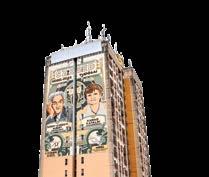
Monumental portraits of SZTE’s two Nobel Prizewinning researchers, two honorary citizens of Szeged, Katalin Karikó and Albert Szent-Györgyi. It was commissioned by the city municipality, based on the graphic design of Erik Fuchs: it was made by mixing 25 colours, using 165 liters of paint on the 64-meter-high, 600-square-meter wall surface.
Accommodation of Katalin Karikó, a biology student at JATE in Szeged.
In addition to the biography, the SZTE website’s Albert Szent-Györgyi Memorial Page reports on new research and news related to the namesake, the rounds of SZTE’s Szent-Györgyi Study Competition, which has been successful since 2012, but also helps those who want to do a Memorial Walk and visit the Szeged locations related to the Nobel Prize-winning rector.
Although she was interested in plants, Katalin Karikó applied to the József Attila University of Szeged after hearing about the Biological Research Centre. As a biology student, he lived at the Herman Ottó Dormitory in Újszeged. Some of the professional classes were held in the Botanical Garden and the Institute of Biology in Újszeged. She crossed the Tisza bridge almost every day to the other side: to the chemistry department in Dóm Square or the biology department in Egyetem Street. As a recent graduate, she changed direction: She lived in Szeged and commuted to work at the Szeged Biological Research Centre, the “biopolis” of Újszeged.
Since 2012, the Tree of Sciences has been in leaf in the park between the SZTE TIK and SZTE BTK buildings, preserving the memory of the conference organized in honor of the 75th anniversary of Albert Szent-Györgyi’s Nobel Prize. On the memorial site, under the pedunculate oak, the circular relief is the work of the sculptor Fritz Mihály: next to Albert Szent-Györgyi and the 9 Nobel laureates visiting the city on the occasion of the anniversary of his award, the inscription reads University of Szeged - Universitas Scientiarum Segedinensis.
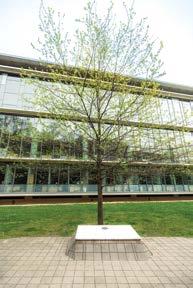 House of Albert Szent-Györgyi
Szeged Biological Research Centre, Katalin Karikó’s first workplace.
SZTE TTIK Institute of Biology, where the university student Katalin Karikó studied.
House of Albert Szent-Györgyi
Szeged Biological Research Centre, Katalin Karikó’s first workplace.
SZTE TTIK Institute of Biology, where the university student Katalin Karikó studied.
 Ilona ÚJSZÁSZI Ádám KOVÁCS-JERNEY
Ilona ÚJSZÁSZI Ádám KOVÁCS-JERNEY
In addition to Albert Szent-Györgyi and Katalin Karikó, who were recognized with the Nobel Prize, the work of several Szeged scientists also stands out when we look at the world of researchers through the prism of the winners of the most significant domestic scientific awards, the Kossuth, Széchenyi, and Bolyai Prizes.
For instance, pathologist doctor József Baló, and his wife, biochemist Ilona Banga , who worked directly with Albert Szent-Györgyi and who could have been a nominee for the Nobel Prize as a muscle researcher, are part of the “knowledge base of Szeged”. Together, the couple won (in 1955) the Kossuth Prize for scientific achievement.
This Hungarian prize, established as a scientific recognition, was twice awarded to Géza Hetényi (1950, 1955), who contributed to the development of internal medicine in Hungary and was also successful at the Szeged clinic (1950, 1955); and István Rusznyák (1949, 1956), who dealt with blood components and lymphatic circulation.
A similar record-holder is the pharmacologist, histochemist, physiologist, and biochemist Miklós Jancsó Jr. (or Gidófalvi) (1948, 1955), whose fundamental findings on a pharmacological receptor for capsaicin on pain sensory nerve endings brought him close to the Nobel Prize.
Albert Szent-Györgyi, who obtained a doctorate also in chemistry and won the Kossuth Prize in 1948, worked together with Győző Bruckner (1949, 1955), an outstanding figure in organic chemistry research and education, and a two-time Kossuth Prize winner.
Kalmár’s logical machine, the 1962 “Szeged Robot Lady” was the cover girl of the magazine Ezer-
mester. Its creator, Kossuth Prize winner László Kalmár (1952), is one of the three equally renowned great scientists of the Szeged mathematical school, along with László Rédei (1950, 1955), Frigyes Riesz (1949, 1953), and Béla Szőkefalvi-Nagy (1950, 1953).
Apart from the tetrahedron, the Szilassi polyhedron is the only known geometric shape bounded by planar faces, that can have any two of its faces meet at an edge. The world-famous geometric shape was named after its discoverer, Lajos Szilassi, an alumnus of the University of Szeged and a mathematics lecturer at SZTE.
The most renowned Hungarian mathematician, László Lovász, taught and researched at the University of Szeged as a young scientist, and as one of the highlights of his work, he won the Széchenyi Prize (2008). This domestic state scientific recognition has already been awarded among a number of Szeged researchers, including a chemist and geochemist, a legal philosopher and literary historian, a pediatrician and a dermatologist, a mathematician and two laser physicists - Zsolt Bor (1994), and most recently the Managing Director of ELI-ALPS, Gábor Szabó (2024).
Several SZTE biologists have been awarded the Széchenyi Prize, including the ecologist László Gallé
(2007), who studied the interactions of ant populations, and one of his students, the biochemist Katalin Karikó (2021).
Researchers affiliated with the University of Szeged include physicist Zsolt Bor (2004), mathematician László Lovász (2007), biologist Csaba Pál (2015), and Katalin Karikó, the world-famous mRNA researcher of SZTE, were also awarded the Bolyai Prize, founded on a civil initiative and given to individuals who have achieved outstanding results in science even by international standards.

TWO HUNGARIAN NOBEL LAUREATES ARE CONNECTED TO THE UNIVERSITY OF SZEGED. ALBERT SZENT-GYÖRGYI’S 1937 NOBEL PRIZE IN PHYSIOLOGY OR MEDICINE WAS THE FIRST TO BE WON BY A RESEARCHER LIVING IN HUNGARY, AND THE FIRST NOBEL PRIZE WON BY A HUNGARIAN WOMAN WAS KATALIN KARIKÓ’S 2023 NOBEL PRIZE IN PHYSIOLOGY OR MEDICINE.
Albert Szent-Györgyi started working at the University of Szeged in January 1931. In Délmagyarország, journalist György Vér already interviewed him in the issue of March 10, 1931, about hexuronic acid, which Szent-Györgyi proved the following year to be identical to vitamin C.
In the laboratory of Albert Szent-Györgyi at the University of Szeged, the effect of hexuronic acid was tested on guinea pigs. The guinea pig has a trait similar to humans in that its body is unable to synthesize vitamin C. Among the animals participating in the experiment, those that had a little lemon juice added to their food did not develop scurvy. After that, Szent-Györgyi started looking for a bigger source of vitamin C.
At the University of Szeged, Albert Szent-Györgyi discovered in 1932 that Szeged paprika contains a large amount of easily extracted vitamin C. According to the story he told, he brought his wife’s pepper salad to the laboratory the next day. A week later, he extracted one and a half kilos of vitamin C from peppers, and in September 1933, he got an acre of land on lease for pepper experiments from the city of Szeged, where he grew the peppers needed for his experiments. The “birthplace of vitamin C” is today’s Déri MiksaTechnical High School building on Kálvária Square in Szeged. This is the only place in Hungary where a Nobel Prize-winning discovery was made. Between 1930 and 1935, Albert Szent-Györgyi lived with his family and worked with his research group in the school building that housed university departments and laboratories, clinics, and service apartments.
After receiving the Nobel Prize in 1937, Albert Szent-Györgyi was greeted by his colleagues at the University of Szeged with the humorous “Paprika Diploma”. Professor Szent-Györgyi, caught in a pepper centrifuge, smokes a pipe, his figure surrounded by dancing lemons and peppers. His favorite sports appear: a laboratory flask marches equipped with skis, two peppers play tennis, one skates, one rides a motorcycle, and one lemon sails on top of waves. An airplane is carrying beef kidneys above a cow shedding tears. (Szent-Györgyi processed a large amount of beef adrenal glands in the US). In the picture, Ilona Banga is sitting in the flask of a Warburg manometer, Mihály Gerendás is holding on to the manometer, and Brunó F. Straub and Kálmán Laki can be seen at the bottom of the picture.
Several interesting facts about the Nobel Prize-winning research of Albert Szent-Györgyi can be found in the virtual exhibition of the SZTE Klebelsberg Kuno

Why is the Nobel Prize the most glorious award? How did the idea of the inventor of dynamite become prestigious? How can a scientist be a Nobel laureate in physics, chemistry, physiology or medicine, literature, or peace?
We searched for answers on the nobelprize.org website and on the pages of Ingrid Carlberg’s monograph: Nobel - The Enigmatic Alfred, His World and His Prize.
STOCKHOLM AND SANREMO
Alfred Bernhard Nobel, the immensely wealthy inventor and „father of dynamite”, died unexpectedly in Sanremo, Italy, at the age of 63. Since 1901, awards have been showered on the greats of science on the anniversaries of his death. On December 10, in the frozen and snowy Swedish capital that was built on 14 islands, a flood of fragrant and colorful flowers brought from Sanremo, on the shores of the Mediterranean Sea, decorates the venue of the Nobel Prize ceremony, the Stockholm Concert Hall. 1
THE WILL
Among the mysteries of the Swedish chemist and inventor’s world is his will dated November 27, 1895. He left only a fraction of his wealth to the Nobel family. According to Alfred Nobel’s final will, the capital released after the sale of all his shares and real estate was to be locked in a separate fund. The interest on this must be awarded annually as a prize to those „who, during the preceding year, have conferred the greatest benefit to humankind”.
5+1 PRIZES
3 7
THE FIRSTS
4
Nobel’s five prizes of equal value were meant to reward those who strive in physics, chemistry, physiology or medicine, literature, and world peace. In 1968, on the 300th anniversary of its existence, the Central Bank of Sweeden added its own Nobel Memorial Prize in Economic Sciences, which became an economic recognition equal to the other five Nobel Prizes.
THE AMOUNT
The author of the latest Nobel biography quotes, the Svenska Dagbladet newspaper of the time as „The largest provision ever made by one person for the cultural and idealistic development of humanity”. Alfred Nobel’s fortune was estimated at 35-50 million kronor, the reward associated with a Nobel Prize in 1901 was 150 thousand kronor (300 million forints in today’s value ). The latter amount corresponded to the 20-year salary of a professor in those days. At that time, each Nobel Prize was worth twice as much as the sum spent on all the prizes of the French Academy of Sciences. That is why the Le Figaro article of the time wrote that Nobel’s will „remains an outstanding monument of love for humanity”.
MEDAL AND DIPLOMA
5
6
In addition to the well-known Nobel medal, each laureate receives a unique work of art in the form of a diploma. The awarding institutions decide on the design of this diploma. The diplomas of researchers who have won a scientific Nobel Prize are made on specially ordered handmade paper.
THE MOST PRESTIGIOUS AWARD
In the second half of the 19th century, it was not uncommon to award scientific achievements, but the Nobel Prize was innovative: the recognition, which comes with a significant monetary reward, is awarded at an international level in a comprehensive evaluation process. The status of the Nobel Prize is raised by the fact that the candidates are selected from the international scientific community and the laureates are selected by a country with a reputation for neutrality.
Among the first Nobel laureates, the German physicist Wilhelm Conrad Röntgen was considered world famous. German bacteriologist Emil von Behring, a medical laureate, was credited with serum therapy against diphtheria and saving thousands of lives. The Dutch chemist Jacobus Henricus van’t Hoff was awarded for the laws governing osmotic pressure. The French poet Sully Prudhomme was recognized among the writers, while the Swiss Jean-Henri Dunant, the founder of the International Red Cross, and the French politician Frédéric Passy were recognized among those who served world peace. Physicist Fülöp Lénárd, who received this award in 1905, was the first among Hungarian or Hungarian-born Nobel laureates. Albert Szent-Györgyi is the first Hungarian who left his homeland and returned here (1937) as a Nobel laureate. The first Hungarian Nobel laureate woman is Katalin Karikó.



Recognitions of excellence in intellectual performance are academic awards. Such awards play a positive role in the development of the prestige and competitiveness of higher education institutions and the ranking of universities. Among the connections, we highlight 4 aspects.
WHERE THE AWARD IS AN INDICATOR.
Among the best-known and most respected international higher education rankings, the world (Academic Ranking of World Universities, ARWU) and specialty (Global Ranking of Academic Subjects, GRAS) rankings of the Shanghai Ranking both treat academic awards as a separate indicator in the evaluation of higher education institutions.
THE WEIGHT OF THE NOBEL PRIZE.
On the ARWU list, for example, the Nobel Prize is an indicator with a weight of 10+20%. The list takes into account the data of the official website of the awards. If the awarded researcher was employed by the institution at the time of winning the Nobel Prize – depending on the year in which the researcher received the award, and whether the award was shared or sole – this is taken into account in the ranking with a weight of 10-25-100%.
In Hungary, only the University of Szeged is associated with such Nobel laureates so far: Albert Szent-Györgyi (1937) and Katalin Karikó (2023).
Source: https://www.shanghairanking.com/methodology/arwu/2023
INDIRECT IMPACT.
Distinguished recognitions can also influence the development of other rankings, such as the annu-
al institutional and disciplinary excellence lists of Times Higher Education World University Rankings (THE) and the Quacquarelli Symonds World University Rankings (QS). In these rankings, academic awards do not appear as an explicit indicator, but their influence is felt indirectly in the measurement of educational and research performance. The awards bring prestige to the university, making it more attractive to students, lecturers, and researchers, thereby increasing the institution’s recognition and its national and international visibility.
THE RESEARCH CULTURE.
The types of academic awards and the way they are awarded vary. Some awards are given by scientific societies, while others are given by government organisations or philanthropic foundations. When awarding them, the jury evaluates the originality, quality, broad impact, and potential of the outstanding intellectual performance, i.e. the scientific results, the contribution to the scientific community, and the work of the nominees. Awards can have a positive impact on the work of researchers and the research culture.


Albert Szent-Györgyi, and Katalin Karikó, professors of the University of Szeged, have been honoured as stars of science among the Nobel laureates. Apart from this single element, many other similarities can be discovered between the Stockholm Nobel Week of 1937 and 2023.
Travel. On December 4, 1937, professor Szent-Györgyi, accompanied by his wife, left Szeged by train to receive the Nobel Prize. They crossed the sea by ferry and arrived in the Swedish capital by train on December 8, 1937. Their daughter, who studied in Cambridge, joined them in Stockholm. Katalin Karikó and her husband departed from Philadelphia, and their plane landed in Stockholm on December 4, 2023. Her guests - from Hungary, Germany and the US - traveled between December 4 and 7 to celebrate with her.
Receptions, meetings. Hungarians in Sweden eagerly awaited the first Hungarian Nobel laureate in 1937 and the first Hungarian woman Nobel laureate in 2023. In honour of both researchers a lunch was hosted by the acting Ambassador of Hungary to Sweden. The two Szeged professors attended the reception held in the Swedish Royal Palace. Both of them answered the questions of the local residents at the events organized by Hungarian organizations based in Sweden. Katalin Karikó also met with schoolchildren.
Presentation. Karikó delivered her Nobel Prize lecture at Karolinska Institute in English before the award ceremony (December 7, 2023), while Szent-Györgyi presented it in German after the award ceremony (December 11, 1937). The Szeged professors both mentioned their associates and colleagues by name. Other than Stockholm, Szent-Györgyi received a standing ovation in Lund on December 7, 1937, and Karikó in Uppsala on December 13, 2023, with their emotional and insightful presentations.
Lucia Festival. As the most sympathetic Nobel laureate of the given year, in 1937 Albert Szent-Györgyi, while in 2023 Katalin Karikó crowned Lucia, the festival of light in Stockholm on December 13. After the Lucia festival that lasted until dawn, Albert Szent-Györgyi and his family traveled to Gothenburg, and the next day, December 15, 1937, sailed to England. Katalin Karikó and her husband took a plane back to their home in Philadelphia on December 14, 2023. Films and reports. The Szent-Györgyi film, made by the light of the Jupiter lamps in Stockholm on December 8, 1937, was shown two days later to the viewers of the Hungarian Newsreel. Several local and international press outlets, Swedish and Hungarian radio, as well as the Hungarian newspaper Est Lapok, reported on the days in Stockholm of the “new conqueror from Szeged”. Swedish public television broadcast a portrait film about Katalin Karikó and the 2023 Nobel laureates. The first Hungarian woman Nobel laureate answered journalists’ questions at press conferences, while the Hungarian public media and the SZTE university press also reported on her programme in accordance with the strict communication rules of the Nobel Foundation.
The first Nobel laureate of the University of Szeged started a new life in America at the age of 54. Albert Szent-Györgyi spent the remaining 39 years of his life on the Atlantic coast in the “Seven Winds” house, and the nearby MBL research institute. What did “the Prof.” do, and how did he live in the US? How is the memory of Szent-Györgyi preserved more than 6,800 kilometers from Szeged? We looked into it.
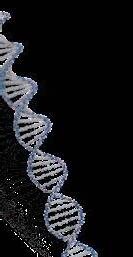
A group of former Szeged JATE and SZOTE students traveled to Woods Hole.
The memory of a lobster dinner. Albert Szent-Györgyi, who was forced to flee Hungary, arrived to New York with his wife and a Swedish passport. He chose the oceanside Woods Hole, near Boston, Massachusetts, as his new home and workplace as he remembered the place from a lobster dinner on his first visit to the United States.
The rest of the Nobel Prize. From the prize money of the most prestigious science
They found that all snakes could accelerate at more than 160 metres per second squared (ms−2) and reach speeds approaching 3 metres per second. This enables the animals to cover average distances of 13.6–16.7 centimetres in 66–74 milliseconds
THE TRIUMPH OF THE INCREDIBLE MOLECULE
1959–1961
Arthur Pardee, Jacques Lucien Monod, and Francois Jacob assume that between DNA as the genetic material and proteins as end products, an information-mediating molecule plays a role in the process of protein synthesis. This was called messenger RNA.
1959–1967
Marshall Warden Nirenberg, J. Heinrich Matthaei, and Har Gobind Khorana clarify the role of mRNA in the process of protein synthesis and decipher the genetic code.
1984
For the first time, scientists were able to microinject synthetic mRNA into frog eggs and produce protein from it in vitro–D. A. Melton, P. A. Krieg, M. R. Rebagliati, T. Maniatis, K. Zinn, and M. R. Green.

On Earth, the lightning frequency is approximately 44 (± 5) second, or nearly 1.4 billion per year and the median is 0.52 seconds made up number of much shorter (strokes) of around 60 microseconds.
award, he bought the house known as „Seven Winds,” which hosted many guests at one time. These days, guards and fences protect most of Cape Cod from visitors. Despite being secured, the Nobel diploma honoring the research results in Szeged and many photos are available to researchers studying the history of science at the director’s room of the Marine Biological Laboratory (MBL).
„Pebble”. Szent-Györgyi and his team worked hard in the lab in the morning, but in the afternoon they swam, boated, fished, water-skied in the ocean, and spent a lot of time around the small house by the water called “Pebble” - we learned from Diana Kenney, MBL’s communications employee. The afternoon tea ritual known from Szeged, was kept on going here as well. These convivial gatherings often evolved into parties.
The „Big hook”. The “Big hook” turned into an exhibition piece for the MBL’s institutional history museum. The “fishing anecdote” was told by the medical Nobel laureate George Wald, and written down by Ralph W. Moss: “I like to fish with a big hook - said Szent-Györgyi, and he meant both fishing and science.” According
to his colleague, the Hungarian scientist “always fished with a big hook and did catch some big fish”.
Jane. Szent-Györgyi carried on with the work he started in Szeged, exploring the biochemistry of muscle contraction, on the ocean shore, with the help of independent researcher Jane McLaughlin, like Ilona Banga did in Szeged.
„Laboratory Without Walls”. Szent-Györgyi is considered one of the founders of two new branches of science: submolecular biology and bioenergetics, based on the results of his time in the US. In 1973, the Laboratory Without Walls was established, a loose association of scientists working under the leadership of Szent-Györgyi, which in its heyday included sixty laboratories from more than a dozen countries.
Wreath, poem, anthem. On September 27, 2023 with the participation of Hungarians from Boston the memorial walk in Woods Hole ended with a wreath-laying ceremony near the “The Church of the Messiah” church in the cemetery – on the occasion of the 130th birthday of Albert Szent-Györgyi and the 50th anniversary of his first trip home from his American emigration.
2000
Katalin Karikó, Drew Weissman, and their associates find that the synthetic mRNA introduced into the immune cell was immunogenic.
1999
Katalin Karikó and her associates successfully delivered synthetic mRNA into a mammalian cell with lipofection, where a functional protein was formed.
2005
Katalin Karikó, Drew Weissman, and their associates discovered that the immunogenicity of synthetic mRNA was due to the lack of modified nucleosides. However, immunogenicity can be abolished by appropriate uridine modifications.
2008
2012
Katalin Karikó, Drew Weissman, and their associates successfully use synthetic mRNA delivery in animal experiments, the mRNA is not immunogenic, and the resulting protein is functional.
2017
2019

Katalin Karikó, Drew Weissman, and their associates find that mRNA containing pseudouridine is translated into protein to a greater extent than normal mRNA.


The world has changed a lot since our first Karikó interview, published on April 9, 2020. One of the indicators of this change is that Katalin Karikó received - jointly with Drew Weissman - the 2023 Nobel Prize in Physiology or Medicine. In the spring of 2024, we asked Katalin Karikó, the Nobel Prize-winning professor at the University of Szeged, about vaccinations and therapy, good and fake news, her favourite food, and her flowers.
Four years ago, the SZTE news portal was one of the first to report that “the founder of the most promising vaccine development against the coronavirus is Katalin Karikó”, an alumna of the University of Szeged.
IT CHANGED MEDICINE
– The Karikó – Weissman research duo received the highest international award for exceptional intellectual achievement. The brief justification for the good news of October 2, 2023 is „for their discoveries regarding nucleoside base modifications that enabled the development of effective mRNA vaccines against COVID-19”. Four years ago in the spring, when the epidemic was declared a pandemic, the WHO announced that more than half a hundred vaccines against the coronavirus were under development. What are the three main reasons why the mRNA-based, modern vaccine became the front-runner?

– A vaccine based on mRNA can be produced very quickly. It does not contain the whole genome of the virus, so it does not cause infection, consequently, it is safe. The third reason is that mRNA rapidly degrades in the body. It is also important to note that the breakthrough in getting the messenger RNA to programme the protein production of human cells in a controlled way was achieved by utilising the work and results of many researchers over several decades.
– Why is that part of the Nobel Prize justification, which refers to your discoveries about modified nucleosides, so important?
– With the procedure based on the modification of mRNA, we managed to overcome the problem that was thought to be unsolvable, which was the inflammation-inducing property of unmodified mRNA. We proved that by modifying one of the components of the mRNA, the inflammatory
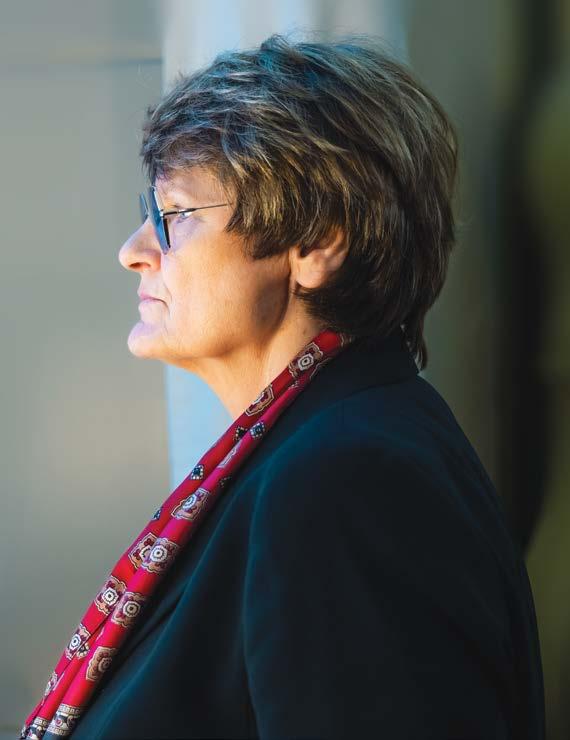
The blue hyacinth & other flowers turned our garden into a garden of Eden.

or immunogenic property of the molecule can be eliminated. Moreover, this change multiplied the efficiency of mRNA-programmed protein production. This discovery has opened the way to the targeted therapy for infectious and non-infectious diseases.
- Does this mean that even if the devastating SARSCoV-2 virus had not appeared, the impact of your discovery would still have changed medicine?
– Yes. The COVID-19 pandemic accelerated the process, drawing public attention to the amazing mRNA molecule, which for the first time proved its efficiency as a vaccine for ordinary people.
SCIENCE AND SPORT ARE SIMILAR
– You spoke about the therapeutic development of mRNA, while Drew Weissman focused on vaccine research in the laureates’ mandatory Nobel lecture on December 7, 2023. What working methods led you to the Karolinska Institute in Stockholm?
– I was also asked about this in the CBS program that recalled the panic four years ago when the first American COVID-19 patient was diagnosed. I also said there: we have very different personalities. Drew is quiet, a man of few words. By a lucky coincidence, we met at a copy machine, a scaled-down 3D printed version, which has since become one of the interesting exhibits at the Nobel Prize Museum in Stockholm. When it comes to science, I use more colloquial language to say the same thing as Drew. He uses mainly technical words. We learnt a lot from each other: I passed on my RNA knowledge, and Drew passed on his knowledge of immunology. We tried to answer all open questions with experiments. We continuously analyzed the results. I prepared the RNAs and Drew tested the immune cells that he had created earlier to see if they caused inflammation or not. We tried to understand the result and find out how to move forward. The essence of our method is that we respect each other, we listen to the other’s opinion, and we don’t try to defeat or oppress each other.
– The Covid-19 pandemic has been contained thanks to the life-saving vaccines. Despite this, anti-vaccine activism, sometimes mistrust of the results of science, and misconceptions and fake news about mRNA are widespread. How can this contradiction be resolved?
– By spreading knowledge. The gap between
the results of science and the knowledge of ordinary educated people is getting wider and deeper.
Bridging this gap is possible only with easy-to-understand explanations. This is the joint task of researchers, educators, and journalists who are ready to spread the knowledge.
– You have become a skilled interviewee over the past four years. In reference to the worldwide success of your memoir entitled Breaking Through, we can say that your life is an open book. On the occasion of the “official interview” on December 6, 2023, which is a mandatory program of the Stockholm Nobel Days, you were expected to answer 17 questions. Which of these questions surprised you the most?
– ‘The similarity I see between science and sport.’ The similarity can be captured in the objective. I remember that the marathon running competition I signed up for quite a few years ago started in November, but I already started training in March. Through my example, my daughter could see that every single day - whether the wind blows, whether it rains, or it is too hot – you have to do something for your future success. Setting a goal and making an effort to achieve it is important in everyone’s life. It is worth working for important goals, no matter if you are an athlete or a researcher.
– The traditional form of knowledge sharing is “Nobel Minds”. At the 2023 round table discussion, out of the ten researchers who received the Nobel Prize, the reporter asked the three woman researcher laureates, including Katalin Karikó, the first Hungarian Nobel Prize-winning woman. What is your answer to the question: what does it take for a mother to be a successful researcher?
– The answer is simple: reliable, high-quality, affordable childcare is needed in order for women researchers to stay on track and not give up on their dreams. An example of this is the daycare network in Hungary, thanks to which I was able to return to the laboratory three months after the birth of my daughter Zsuzsi. Nowadays, women working in the academic sphere are greatly helped by the freedom provided by flexible working hours and the possibility of remote work.
– The series of awards did not end with the Nobel Prize. Most recently, on March 19, 2024, we reported that „Katalin Karikó received the 2023 Nierenberg

Prize for those practicing science in the public interest”. What is the name of the award about?
– I answer with a question: do “science for the public interest” or “public interest science” mean the same thing? In my view, public interest science is what interests the public. An example of this is the weather forecast. The science that serves the interests of the public is another category.
– Your inspiring stories provide a topic in the most diverse circles. In the US academic sphere, for example, the difficulties and contradictions of research funding are called The Karikó Problem. Between October 2023 and March 2024, you achieved the highest number of likes on social media with photos of your hydroponic hyacinth project. Is the admirer of the mRNA molecule still interested in plants?
– The blue hyacinth and other flowers turned our small Kisújszállás garden into a garden of Eden. I love to see the same flowers in our house in Philadelphia as I did when I was a kid. The idea of hydroponic cultivation comes from the fact that, as a child, when I went to visit my grandmother on Nagy Imre Street in Kisújszállás in the winter, I lingered at Zsuzsika Pólyáné’s window to admire her beautiful flowers grown in water. I found it interesting, because I hadn’t seen such a thing before, that the flower bulbs were not in a pot, but in a vase of water. Decades later, in the US, I accidentally saw a hydroponic vase in the store and remembered my childhood experience…
RETURNING HOME TO THE ALMA MATER
– In the interview four years ago, I asked you: “What is your relationship with the University of Szeged?” Your answer was to the point: “Unfortunately, I don’t have a professional relationship.” How has this situation changed since 2020?
– I was asked both in the “Official Nobel Interview” and during the “Nobel Minds 2023” round table discussion, how it felt to visit Hungary after the award was announced. They even showed video footage of the wonderful moments of my reception in Szeged. I was happy to recall the memory of that uplifting sunny day of October 12, 2023. I think of the many hundreds of people who gathered for my arrival with the same affection as the 3-5 researchers with whom I have a direct working relationship, with
whom I can also meet in my university study room, following in the footsteps of Albert Szent-Györgyi.
– On a working day in Szeged, do you go to Hági to eat “sour cherry soup with sour cream”, as you planned as an enrolling high school student?
– Both Hági and my taste have changed. I usually go to a restaurant in Kisújszállás for a lamb stew and in the Szeged area for a fish soup.
– In 2023, a prize of 11 million Swedish kronor, more than HUF 368 million, was awarded to each Nobel Prize category, regardless of the number of awarded researchers. What do you spend your Nobel prize money on?
– I will not change my previous habits. I don’t have expensive hobbies. I don’t wear jewelry, except occasionally the chain I got from the Nobel Prize Museum with the silver medallion in the shape of the structure of the modified nucleoside. With the money I received with the awards recognizing my research work, I support education, I help the work of researchers, including the researchers of my Szeged alma mater, and talent management.
– You received the Nobel Prize three years after the achievement of the mRNA vaccine. Is this 18-karat gold medal just another accolade on the wall of fame in your Philadelphia study, among over a hundred other accolades, or will it change your life?
– I left BioNTech in October 2022 and moved back to Philadelphia to focus on developing a therapy for a very serious neurodegenerative disease. I have been working on this for decades. Unfortunately, in the past year, I could not immerse myself in my work, because I constantly spent most of my time in airports and airplanes, giving lectures online or in person, or making video recordings. For me, the development of the mentioned therapy is the most important task and I would like to dedicate all my time to this program in the future. I adhere to the warning of János Ludwig, my colleague at the Biological Research Centre in Szeged, who wrote to me after the Nobel Prize was awarded: “Katalin, ...if the difficulties in recent years have not deterred you from solving increasingly important tasks, I hope success and widespread recognition will not lead to this either!”

Alfred Nobel’s will was carried out: in 2023, the Nobel Prize in Physiology or Medicine was awarded to the person who made the most important discovery in the field of life sciences. Katalin Karikó and Drew Weissman shared the award “for their discoveries concerning nucleoside base modifications that enabled the development of effective mRNA vaccines against COVID-19.”
Katalin Karikó was first congratulated by her husband, Béla Francia, after receiving a telephone notification from the Karolinska Institute in Stockholm on October 2, 2023. Then the still “embargoed news” was shared with family members, from Budapest to San Diego.
More than 13,000 people watched the announcement of the Nobel Committee and the broadcast of the press conference in the first few minutes. Katalin Karikó received the congratulations with a phone in both hands, while also trying to listen to how the Nobel Committee justified the recognition. It was also stated in the eulogy: Katalin Karikó graduated from the University of Szeged with a degree in biology and obtained her PhD in biochemistry here in 1982. She started her research at her first workplace, the Biological Research Centre in Szeged...
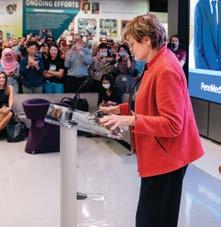

Upon the news of the new Nobel Prize in Physiology or Medicine, major American TV networks and well-known international media companies sent their representatives to the press conference at the University of Pennsylvania, UPenn, in Philadelphia, PA, on October 2, 2023. Casting a shadow over the good news, we also reported that just ten years ago, in 2013, Katalin Karikó’s life took a dramatic turn when her job at the University of Pennsylvania was terminated. She was not reinstated even after the University of Pennsylvania patented the technology as a result of Karikó and Weissman’s research in 2005.
To continue her research work, Katalin Karikó had to move from the United States to Germany, away from her family.
Hundreds of people gathered in the Smilow building of the UPenn Perelman School of Medicine for a “flash mob” to welcome the new Nobel laureates, Katalin Karikó, and the institution’s professor Drew Weissman. The mRNA researcher accepted the ovation and took selfies with her usual directness. The colleagues she once worked with at the University of Pennsylvania celebrated Katalin Karikó with boundless love, rejoicing with her at the Nobel Prize she had won as the fruit of her hard work.
The report of our correspondents - Ilona Újszászi and István Sahin-Tóth - is available here:
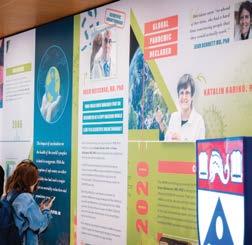
In the week of the announcement of Katalin Karikó’s Nobel Prize in Physiology or Medicine, the memoir „Breaking Through - My Life in Science” was published in Hungarian. The memoir hit bookstores in Hungary on October 4, 2023, and the English version in the United States on October 10.
The Hungarian book launch of Breaking Through was a world premiere. At the event on October 11, 2023, at the headquarters of the Hungarian Academy of Sciences, former TV reporter János Horvát asked Katalin Karikó and her sister Zsuzsanna Karikó about the details. The pleasant conversation was preceded by the press conference of the Nobel Prize-winning researcher and ended with a book signing that lasted for many minutes.
During breaks at the conference, organized to commemorate the 50th anniversary of the founding of the Szeged Biological Research Centre—Katalin Karikó’s first workplace—and at the gala dinner, she signed hundreds of “autographs” on the inside cover of her book.
The success of Breaking Through is unbroken: the British, the French, the Germans, the Japanese, and the Chinese can already read the reminiscences of the research professor of the University of Szeged in their native language, and they can be convinced of the truth of Bill Gates’ book recommendation: „The story of Katalin Karikó has an inspiring power. A must-read for anyone who has ever doubted that science, innovation, and determination can change the world.”
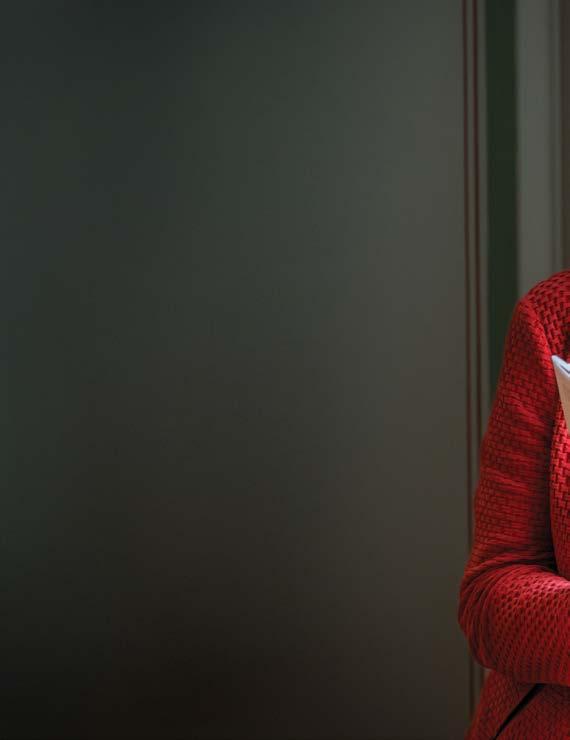
The story of Katalin Karikó has an inspiring power. A mustread for anyone who has ever doubted that science, innovation, and determination can change the world.
Bill Gates
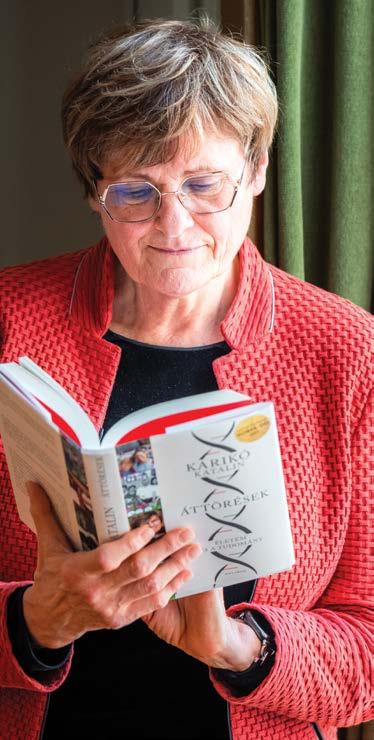
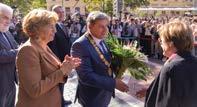
On October 12, 2023, at 1:00 p.m., a celebrating crowd – completely unusual for a weekday – filled Dugonics Square in Szeged. The citizens of the university and the city greeted Katalin Karikó, the Nobel Prize-winning research professor and alumna of the University of Szeged, with prolonged applause and cheers as she arrived for the university celebration. In front of the University of Szeged Rector’s Office, right next to the statue of Albert Szent-Györgyi, Professor Karikó was greeted by Prof. Dr. Gábor Szabó, chairman of the Board of Trustees of the Foundation for the University of Szeged, Prof. Dr. László Rovó, rector of the University of Szeged, Dr. Judit Fendler, chancellor of the University of Szeged, Dr. László Botka, mayor of the city of Szeged, and Dr. László Salgó, head of the Csongrád-Csanád County Government Office. Katalin Karikó received the welcome bouquet from Prof. Dr. László Rovó, then, moved by the reception, waved emotionally to the crowd. The university leaders then escorted her to the Ceremonial Hall of the Rector’s Office, where the university’s researchers, teachers, and medical professionals greeted her with standing applause.
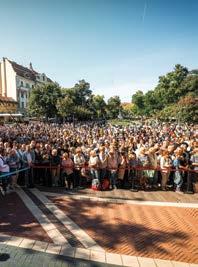
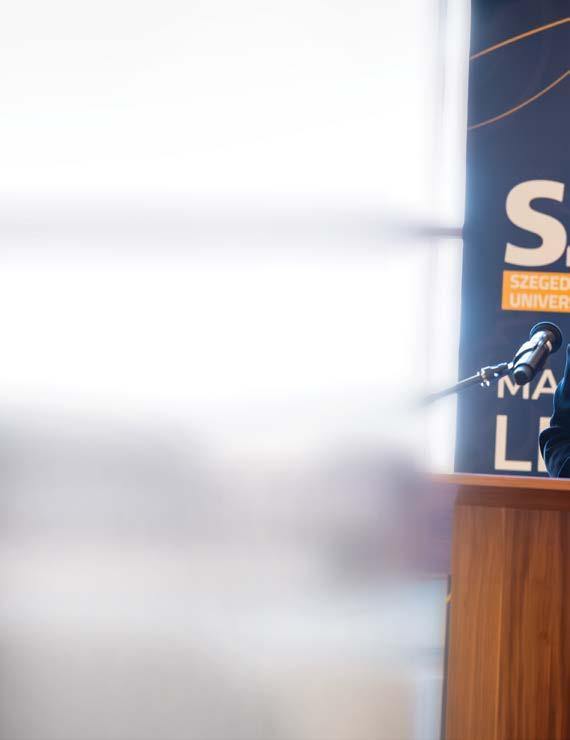
Prof. Dr. László Rovó, the rector drove Katalin Karikó from the JATE Club to Dóm Square in a Volkswagen Beetle convertible on October 12, 2023.
Following in the footsteps of Nobel laureate Albert Szent-Györgyi, the Nobel Prize-winning mRNA researcher and SZTE research professor took over her office at the Institute of Chemistry, and then delivered a short speech from the terrace to the celebrating crowd gathered in the square.
– Thank you very much for coming and celebrating with me! My colleague Drew Weissman must not have been received by such a large audience! I couldn’t catch my breath in the car either, I just looked left and right to see how many of you had come. I will come back with the medal and show it to you – Katalin Karikó concluded her speech standing on the balcony of the university building opposite the Votive Church and then added: – I am also happy that Albert Szent-Györgyi was here 50 years ago, we are very proud that he won the Nobel Prize in Medicine. It’s incredible, but I did too!
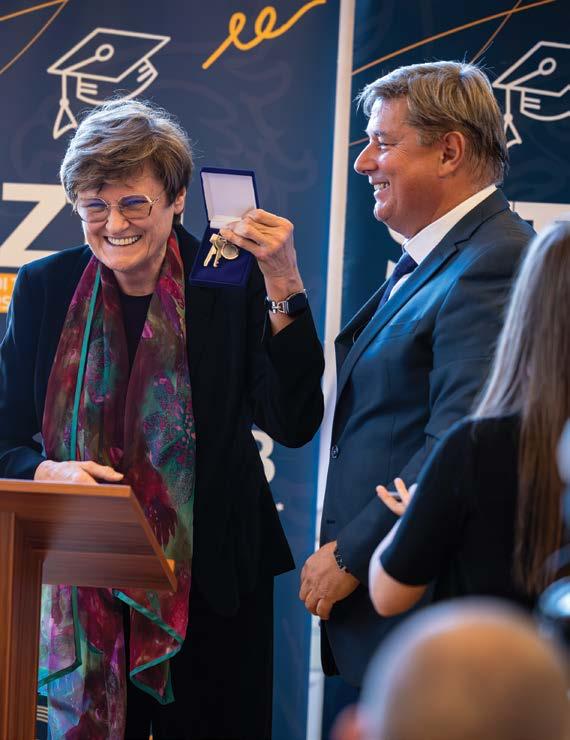
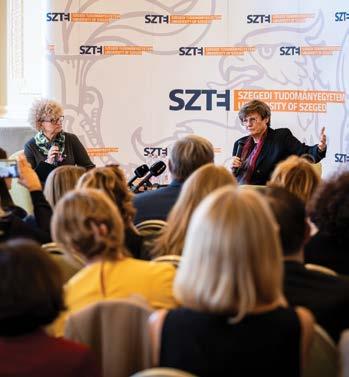
The Nobel Prize-winning professor of the University of Szeged, Dr. Katalin Karikó allocates the financial rewards from her scientific awards to support talent management, education, and research, among other things. During her visit to Szeged after the announcement of her Nobel Prize, on October 12, 2023, she also met with Szeged researchers whose work she monitors and assists.
The project entitled “Development of a multifunctional, microbial animal house and examination of vaccination options against opportunistic fungi” was presented by Professor Attila Gácser, Head of the Institute of Biology of Faculty of Science and Informatics at the University of Szeged. Dr. Zoltán Fekécs, assistant lecturer at the Laboratory of Neural Regeneration at the Department of Anatomy, Histology, and Embryology at the University of Szeged’s Albert Szent-Györgyi Medical School, also outlined his ideas on mapping the effect and expression of intravenously administered mRNA-LNP. How can a malignant brain tumor be treated more effectively through intranasal delivery of siRNA? Dr. Gábor Katona, assistant professor at the Institute of Pharmaceutical Technology and Regulatory Affairs at the University of Szeged’s Faculty of Pharmacy, is looking for an answer to this question. The leaders of SZTE also participated in the professional discourse.
– I was surprised by the emergence of anti-vaccine activism; when I was a child, they were happy if there was a vaccine against a disease – said Katalin Karikó, who was celebrated as a Nobel laureate, on October 12, 2023, in the Ceremonial Hall of the SZTE Rector’s Building, where she answered questions from journalists. – The reason for the anti-vaccination movement was the lack of knowledge; while the experts were working on vaccine development, people who studied immunology on Facebook began to comment. Not a single doctor who treated patients during the pandemic denied the epidemic or the vaccine! Now, together with you, journalists, we have a common task to help those who want to understand scientific results. Believe in what we do, in science there is always correction, and sooner or later the truth always comes out. Even a hundred years ago, people doubted the use of, for example, X-rays. Some lobbied for radiation that penetrates clothes not to be included in theatre binoculars because then people would be able to be watched naked. However, they spread half-truths because they did not mention that the X-ray also passes through the body and that only the skeleton could have been seen in the theatre. Not to mention that those who spread this nonsense made money from it: that’s when they started selling X-ray-resistant underwear.
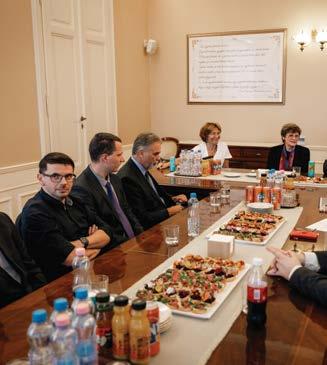
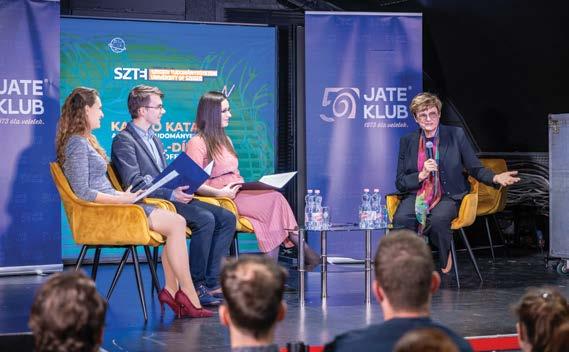
During her visit on October 12, 2023, Katalin Karikó met with Hungarian and international students at the University of Szeged. The interesting thing about the event was that half a century earlier, on October 12, 1973, Nobel laureate Albert Szent-Györgyi talked to university students in the newly opened JATE Club.
Nobel laureate Katalin Karikó took part in a seminar discussion at the 50-year-old JATE Club. The students asked her about learning methods, important milestones in her life, data processing techniques, and tricks for building relationships. When they inquired whether she had passed all her exams on the first attempt, she replied: ‘I failed only one exam in my entire life, and it was in the US, specifically the driving test. My husband told me to keep one foot on the gas and the other on the brake, but in the US they don’t allow that. By the way, I was always a good student when I was in primary, secondary school, and university, and I never got a 2 for anything. I got a 3 once, in philosophy, even though I studied a lot for that exam as well.”
Prof. Dr. László Rovó, the rector drove Katalin Karikó from the JATE Club to Dóm Square in a Volkswagen Beetle convertible on October 12, 2023. Following in the footsteps of Nobel laureate Albert Szent-Györgyi, the Nobel Prize-winning mRNA researcher and SZTE research professor took over her office at the Institute of Chemistry, and then delivered a short speech from the terrace to the celebrating crowd gathered in the square.
– Thank you very much for coming and celebrating with me! My colleague Drew Weissman must not have been received by such a large audience! I couldn’t catch my breath in the car either, I just looked left and right to see how many of you had come. I will come back with the medal and show it to you – Katalin Karikó concluded her speech standing on the balcony of the university building opposite the Votive Church and then added: – I am also happy that Albert Szent-Györgyi was here 50 years ago, we are very proud that he won the Nobel Prize in Medicine. It’s incredible, but I did too!
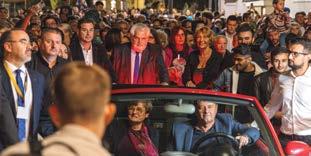
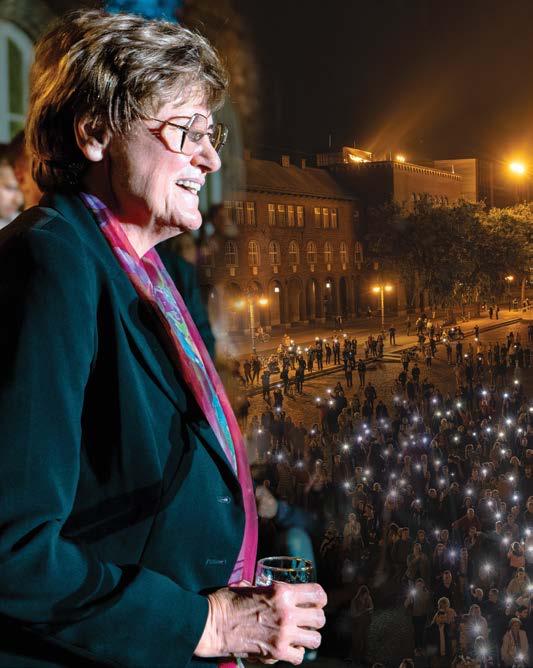
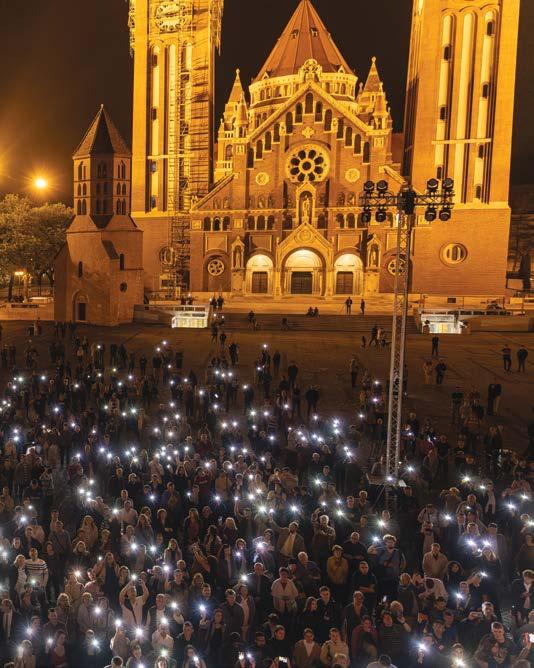
According to Prof. Dr. Márta Széll, SZTE’s Vice-Rector for Strategic Planning, there is an arc of scientific history between the major biochemical research laboratories founded by Kuno Klebelsberg at the University of Szeged and the new Nobel Prize.
Prof. Dr. Márta Széll, Vice-Rector for Strategic Planning at the University of Szeged, gave an interview to our magazine in connection with Katalin Karikó’s Nobel Prize. According to the professor of molecular biology, the developments made in the first decade of the University of Szeged have a lasting impact due to the network-like character of science.
– At the end of the 1920s, Kuno Klebelsberg initiated the establishment of a world-class biochemical and life sciences research centre at the University of Szeged. To achieve this, he invited Albert Szent-Györgyi back to Hungary, and within ten years the vision was confirmed: in 1937 Szent-Györgyi received the Nobel Prize for investigating the processes of biological combustion and for the discovery of vitamin C. The impact of the Nobel Prize and Szent-Györgyi went much further, leading to the establishment of research schools that developed and became extremely important in their own right. One of these schools was the research direction marked by Brunó F. Straub and Ilona Banga, which investigated muscle function and led to the world-famous discovery of actin. The identification, isolation, and first description of this molecule are also linked to the University of Szeged.
Both Brunó F. Straub and Ilona Banga were students of Albert Szent-Györgyi and were employed
by him. In addition to these intellectual workshops, further life science schools were established at the University of Szeged, such as that of Miklós Jancsó Jr., who studied the inflammation of neural origin and the inflammation mechanism of sensory nerve endings. He was the first to describe the sensory neuron-blocking effect of capsaicin. In 2021, the Nobel Prize in Physiology or Medicine was awarded to David Julius and Ardem Patapoutian for identifying the capsaicin receptor, and their discovery was also built upon the work of Miklós Jancsó Jr. – explained Dr. Márta Széll.
According to the molecular biologist, it is no coincidence that the Biological Research Centre of the Hungarian Academy of Sciences (BRC) was opened in Szeged. – At the end of the 1960s, the scientific strength of the research laboratories of the University of Szeged was demonstrated by the fact that the research centre of the academy was moved to Szeged.
Brunó F. Straub, the founding director general of BRC, who was trained as a researcher at the school of Albert Szent-Györgyi, made an indelible contribution to this. We have recently celebrated the 50th anniversary of the founding of the research centre, the memorable opening ceremony was held on 11 October 1973, and since that day, the university and BRC have been working in a mutually inspiring, clo-
se professional relationship. The biology education of the University of Szeged provides the main base of young researchers for the research centre, and BRC provides the research background for the doctoral schools of the university – said Dr. Márta Széll.
According to Márta Széll, Katalin Karikó’s speech at Dóm Square, when she said that she came home to the University of Szeged to celebrate the news of the Nobel Prize, was one of SZTE’s greatest moments.
– Katalin Karikó graduated as a biologist from the University of Szeged, where she acquired her fundamental biological knowledge, including her knowledge of molecular biology, which she then used in the first seven years of her career at the Szeged Biological Research Centre. She was involved in incredibly groundbreaking projects, for example, in the research group led by Ernő Duda where she inves-

tigated how liposomes can be used to deliver DNA into cells. It was also at BRC that she learnt the first steps in modifying nucleotides, the cornerstones of RNA molecules. When she went to the US to do research, she left with this well-founded knowledge base. This knowledge base was so strong that she in fact, – as she emphasised –spent her whole life doing research on her own. She developed her research concepts, carried out and interpreted her experiments, and then wrote articles based on them completely on her own. She didn’t have a supervisor with whom she could have consulted, nor did she have assigned Ph.D. students, and she repeatedly pointed out that she did all the pipetting in the laboratory herself until the age of 58. She achieved her results as a true solo researcher, thanks to her incredible inner motivation and well-founded knowledge base.
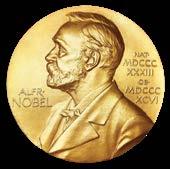
Two Hungarian Nobel Prize-winning researchers, also affiliated with the University of Szeged, received the world’s most famous scientific award on December 10, 2023. mRNA researcher Katalin Karikó, a professor at the University of Szeged, is the first Hungarian woman to receive the Nobel Prize in Physiology or Medicine. Ferenc Krausz, who conducts his molecular fingerprint research in Szeged, received the Nobel Prize in Physics.
The elements of the traditional Nobel ceremony series were happening in perfect interconnectedness.
The Stockholm Concert Hall evokes the beauty of Greek temples. The colonnade, illuminated with strings of lights, and the Orpheus Well sculpture group in front of the building bathed in a wonderful blue color, tuning those arriving at the Nobel Prize ceremony to the magic of music, arts, and science. The television companies broadcast it live, and the whole world could see it: the award ceremony took place according to the traditional protocol in 2023 as well.
– The Nobel Prize ceremony is a family program for

the Swedes. At this time in Stockholm apartments, families sit in front of the dinner table and follow the royal ceremony attentively – Adrien Müller, Ambassador of Hungary to Sweden, a graduate of the University of Szeged Faculty of Law, revealed one element of the local tradition.
The researchers who won the Nobel Prize in Physics, including Ferenc Krausz, were praised by Swedish physicist Professor Eva Olsson. In her speech, she talked about how the way to understand the vast universe is through the observation of phenomena with small timescales. She said: „A heartbeat lasts for one thousand thousand thousand thousand thousand thousand attoseconds. (…) The attosecond is the time scale of the world of elec-

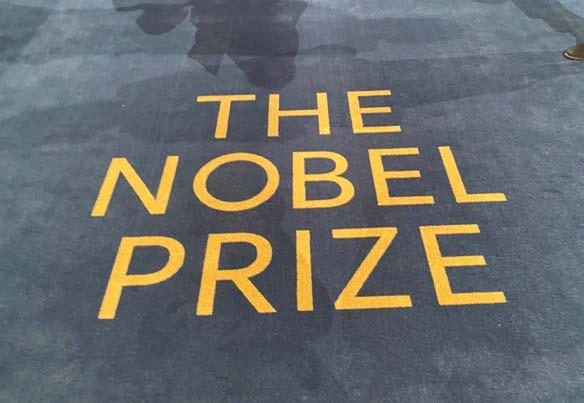

trons – a world that we now can explore.”
Gunilla Karlsson Hedestam, who welcomed the Nobel laureates in Physiology or Medicine, highlighted in her speech that since the discovery of the messenger RNA molecule in 1961, the molecule carrying information from DNA has been routinely investigated in biochemical research, until Katalin Karikó in 2005, together with Drew Weissman, developed a patent for mRNA therapeutic applications containing modified nucleosides. Fifteen years later, the discovery saved millions of lives.
In 1937, the name of the University of Szeged was announced at the Nobel ceremony thanks to Szent-Györgyi, and in 2023 thanks to Karikó. The audience greeted the first Hungarian Nobel laureate woman with a huge ovation. An excerpt from Ferenc Lehár’s last operetta, Giuditta, was played in her honor.
His Majesty, Carl XVI Gustaf, king of Sweden, hand-
ed over the Nobel medal and diploma to a total of ten awardees.
GUESTS FROM ACROSS THE OCEAN
Katalin Karikó invited 14 guests to the Stockholm Nobel Week. Her husband, Béla Francia, accompanied her to the eventful programs in the Swedish capital. Their daughter, Zsuzsanna Francia, and her family – her husband and their little son, Sanyika, as well as their daughter, Zsuzsi – flew across the ocean. Zsuzsanna Karikó, the awardee’s sister, also appeared at the ceremony.
László Orosz and Pál Venetianer, the two professors and academics, former lecturers of the József Attila University of Szeged, honored the research professor of the University of Szeged with their personal presence; furthermore, among her mentors from the Szeged Biological Research Centre, SZTE professor Ernő Duda, and academician Éva Kondo-


rosi, as well as academician László Vigh and professor Aladár Szalay. Her former American colleagues, Elliot Barnathan and David Langer, also came to the important occasion, as well as Holger Kissel and Gábor Tamás Szabó, representing her group formed at BioNTech in Mainz. Norbert Pardi, who is mentored by Katalin Karikó and Drew Weissman, joint laureates of the 2023 Nobel Prize in Physiology or Medicine, also took part in the celebration.
The Nobel Prize ceremony continued with a banquet organized in the Blue Hall of the Stockholm City Hall. In the largest space of the City Hall, reminiscent of the Dóm Square building complex in Szeged, 1,300 celebrants tasted the special menu inspired by the sea, and the Shaman Rosé Grand Cru Champagne. During the time between the various courses, all the Nobel Prize-winning scientists held a toast. Katalin
Karikó emphasized on behalf of her fellow researcher: “We are very grateful to all those who helped us on our way.”
Warmed up by the delicious food and drinks, the guests marched into the Golden Hall, where the dance began. Katalin Karikó’s daughter waltzed with her husband wearing the “most beautiful evening dress”.
Students were among the guests of the banquet – shaped into a gala program with musical inserts – including Dániel Viczián, a first-year chemistry student at the University of Szeged, who was the only one from Hungary who won the right to participate. He participated in the KTH Royal Institute of Technology’s black-and-white programme, the Students’ Nobel NightCap, SNNC party, benefiting from Alfred Nobel’s legacy in this way too.
One of the main profiles of ELI ALPS in Szeged is the production of attosecond light pulses, for which Ferenc Krausz, Anne L’Huillier, and Pierre Agostini received the Nobel Prize in 2023.
Attosecond physics, the new, active research area of physics that deals with the research of ultrafast phenomena of light-matter interaction, was named after the incredibly short duration of 10-18 seconds. The smaller the size of the system to be examined, the faster its movement; one attosecond is enough for light to travel from one hydrogen atom of a water molecule to another. In 2023, the Nobel Prize in Physics was awarded for the production of attosecond light pulses. This application paved the way for the “imaging” of ultrafast processes in submolecular systems.
One of the international centres of this scientific field is the ELI ALPS research institute in Szeged, which provides researchers of atomic, molecular, and optical processes with attosecond pulses of world-unique intensity. At ELI ALPS, laser pulses with a duration of a few femtoseconds (10-15 mp) are used to generate even shorter, attosecond (10-18 mp) light pulses. They are produced using two basic technologies: in one case, the laser pulses focused into a gas jet, and in the other, the plasma created by the laser pulses on a solid surface creates the high-order harmonics of the laser

light, i.e. the attosecond pulses. Laser physicist Prof. Dr. Gábor Szabó (SZTE), managing director of ELI ALPS, described the attosecond technique as follows:
- A process that can be used to produce extremely short pulses of light. It can also be considered as a flash with which the fastest processes can be frozen in time. These processes may be related to the movement of electrons, which had not yet been directly observed before attosecond methods. What happens on this time scale can be important for physics, materials science, and life sciences as well. We expect a lot of results from attophysics here at ELI ALPS, because at the moment we have the most attosecond sources, we produce the ultrashort light pulses on 5 different types of beam lines. We expect that more and more users will bring experiments to our resources, and in the coming years, we will be able to read about scientific breakthroughs made with the attosecond physics tools of ELI ALPS.
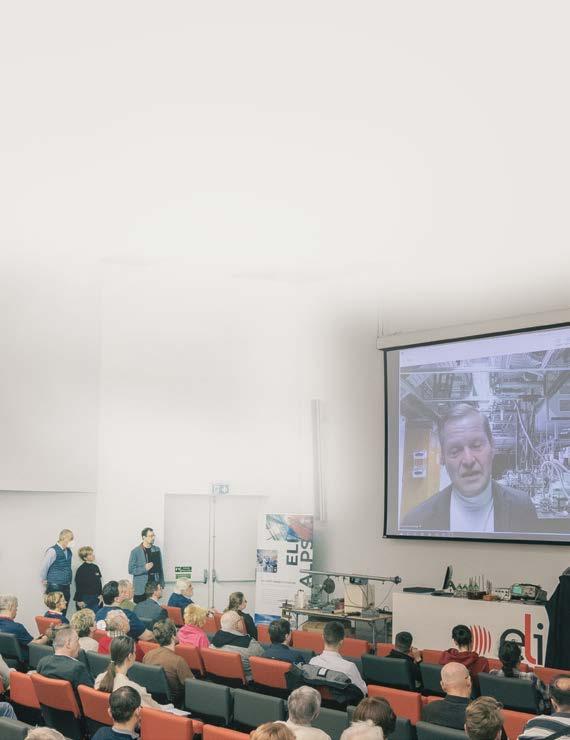
The founders of attosecond physics, including Ferenc Krausz, received the 2023 Nobel Prize in Physics. In connection with this sensational news of October 3, 2023, the Hungarian public learned that the researcher with Hungarian and Austrian citizenship currently lives and works in Germany, but is also closely connected to the University of Szeged and the ELI ALPS Laser Research Institute. During Nobel Week in Stockholm, we asked Ferenc Krausz about this connection network, about running, and about his involvement with the establishment of the laser institute in Szeged.

– The 2023 Nobel Prize in Physics was jointly awarded to Ferenc Krausz, Pierre Agostini, and Anne L’Huillier „for experimental methods that generate attosecond pulses of light for the study of electron dynamics in matter”. How would you summarize the essence of your Nobel Prize-recognized research results in a sentence more comprehensible for everyone?
– We have developed fast photography to study microscopic processes.
– What example could you use to illustrate this short sentence?
– If you need to take a target photo of two Formula
1 racing cars driving side by side to decide which one is the winner, you will need a camera with an extremely short exposure time. The condition to capturing the decisive sharp image, is that the cars do not move until the film is exposed. This is the essence of short exposure time. That means roughly a thousandth of a second. Compared to this, the exposure time of the camera must be shortened by many orders of magnitude, almost a billion times, to be able to take sharp snapshots of electrons. We can reconstruct the movement of the electrons from a series of these snapshots.

– Under the title “Atoms and electrons in motion”, subtitled “Snapshots with femto- and attosecond light pulses”, you wrote the essence of your work, which has now been recognized with the Nobel Prize, in the 2002/01 issue of the Fizikai Szemle. Motion is also a defining part of your life. In the film about the 2023 Nobel laureates, which was also shown on Swedish public television, you run and run and run along the river bank for long minutes. Do you think exercise is that important?
– I have always loved to move. Already at a young age, I realized that it is good to combine theoretical activity
What advice would you give to young people starting their careers, what research field should they start in? –Ferenc Krausz was asked at the Physics Day in Szeged. He does not want to advise on any particular direction, said the researcher, in fact, he would rather advise the opposite: in the first period, look around in as many directions as possible, with as much openness as possible. You should deal with the questions raised by different fields of science. In this way, sooner or later, you will find the questions that are worth devoting a lifetime of research to. „I would advise you to pursue finding this! From then on, ‘work-life balance’, i.e. connecting work and private life, will not be unsolvable, but will not even arise. If we have found the right question and the resulting tasks, from then on we will be in the privileged position of considering work as our hobby.”
with physical activity. Then, for one and a half to two decades, work and family filled my life, there was no time left for sport, it was pushed into the background. Slowly appearing health problems brought me back to this path. I have been exercising regularly again for roughly fifteen years, which I wholeheartedly recommend to everyone. You can start or restart sports, exercise, and running at any age.
– On December 8, 2023, the three awarded physicists gave their Nobel lecture. What do you say about the fact that three countries feel connected to Ferenc Krausz’s share of the 2023 Nobel Prize in Physics?
– That’s perfectly legitimate. I am very pleased with this. The three countries from which I received a lot are Hungary, Austria, and Germany. I was able to give something back to these countries through the Nobel Prize…
– How will the 2023 Nobel Prize shed light on laser research in Hungary, including laser research in Szeged?
– I am glad that this award also reflects that extremely high-quality research work has been going on in Hungary for decades, especially in the fields of laser physics and its applications. The names of a whole line of my colleagues are a hallmark of this. Researchers whose names are known not only in Hungary but throughout the world. Quite a few of them worked or are working at the University of Szeged: for example, Professor Gábor Szabó, Professor Zsolt Bor, and Professor Sándor Szatmári. They are all world-renowned colleagues. It is also thanks to them and the schools they established that the ELI ALPS laser research centre was brought to Hungary, and built in Szeged. We are all proud of the ELI ALPS Laser Research Institute.
In January 2024, Ferenc Krausz participated in the Physics Day event of the University of Szeged by joining from the Max Planck Institute in Munich and answered the questions of the high school students sitting in the ELI ALPS. In response to a question about their infrared laser method that produces molecular fingerprints, he explained that it is not the only method for such examinations, but it can likely conduct the examination of most components in unit time at the lowest cost. Mass spectrometry measurements are available, but they are expensive, and take a few hours to measure a single profile, and are not suitable for mass screening of the population.
thinking that Europe could be a good home for an institution like the Extreme Light Infrastructure (ELI) infrastructure. Originally, it was about focusing on extremely high intensity, and applications related to high-intensity lasers. Attosecond pulses were also included in the project a little later. This was my initiative. This also became part of the concept. The Hungarian colleagues did a lot to ensure that this laser research centre was established in Hungary after attosecond physics became part of the whole project.
– Did your experiments at the ELI ALPS research centre, i.e. in Hungary, also contribute to your Nobel Prize?
According to Ferenc Krausz, the manually operated prototype of their own instrument can measure 100 samples in 8 hours, which automation can speed up even more. The construction price of the equipment is currently 0.5 million euros, and it can also get cheaper. They also calculated that conducting a test would cost 20-30 euros, an amount of the same magnitude as the cost of determining a single biomarker in a measurement using other methods.
– In 2017, you gave a lecture at the inauguration of the ELI Attosecond Light Pulse Source (ELI ALPS) facility built in Szeged, which also houses the large research equipment. I heard at the ceremony that you played a decisive role in the birth of this laser research centre. What was this role?
– Thank you for the honourable question. The beginning of the story goes back at least 15 years, when together with my colleague and friend Gérard Mourou, at his initiative, quite a few of us started
– I am glad that our project, the molecular fingerprinting research project, will also take place at the ELI ALPS Laser Research Centre for a few more years. Until – expectedly around 2027 – it gets its own home in Budapest.
– What other Hungarian research institutes do you cooperate with?
– Concerning molecular fingerprint research, we are connected to the clinical networks of all four major Hungarian universities. In the field of physics, we also cooperate with the Wigner Physics Research Centre and the University of Szeged.
– What do Austria and Germany have to do with Krausz’s Nobel Prize?
– Austria can claim it its own because the experiments that led to the Nobel Prize-winning research took place at the Vienna University of Technology. Germany can claim it because the resources were available there, with which it was possible to expand the research to such an extent that it spread

throughout the world. We established a group in Germany, whose members are now professors in various parts of the world – from Sydney, Australia, to Stanford, California, to Sweden. This expansion also contributed to the spread of this field throughout the world.
– What comes after receiving the Nobel Prize?
– The Nobel Prize is a huge responsibility. We have big plans. I don’t want to lean back in a chair. I see this award as a mandate that, with this new kind of tailwind that the Nobel Prize provides, we can work at an even greater pace on the projects we have started, especially the Infrared Fingerprint, Early Detection of Diseases project.
– The most important goal for the rest of my life is to lay down the foundations for future preventive medicine, and to do it in Hungary – says Nobel Prize-winning physicist Ferenc Krausz. Ferenc Krausz and his team have been working for many years to understand the interaction of light and electrons, which gave him the idea to illuminate the blood with high-intensity laser light to provide information for the early detection of diseases. In terms of physics, the basis is that blood samples are illuminated with an ultra-short single optical cycle infrared light pulse, and during this pulse, the atoms of the blood molecules vibrate. As a result, they emit infrared light waves. The resulting waves will be characterised by the molecules’ own vibrational frequency. Ferenc Krausz’s research group is able to scan these waves with a particularly sensitive method, using attosecond light pulses. In this way, a huge amount of information is generated that characterises each molecule of the blood sample. Since the molecular composition of the blood changes due to the diseases that develop in the body, the information collected periodically can indicate the early stage of a disease - much earlier than when the patient goes to the doctor, already having symptoms.
If it is possible to take blood samples from a large enough number of patients and measure them, the results can be used to train an algorithm to recognise the molecular abnormalities that are specific to a particular disease. Ferenc Krausz continues the molecular fingerprinting research program in Hungary for the fourth year. His domestic research seeks to answer the question of whether the method is suitable for monitoring the overall state of health. Ferenc Krausz hopes that, in time, the preventive medicine of the future will be developed, in which blood samples are taken regularly from healthy people, and with the analysis of these samples it will be possible to diagnose diseases at an early stage. For this purpose, the Nobel Prize-winning researcher founded the Center for Molecular Fingerprinting (https://www.cmf.hu/en/), which has two basic activities linked to the Szeged research agglomeration: around 40,000 blood samples from the current 10,000 volunteer blood donors are stored in the Biobank of the University of Szeged, and the infrared laser examination of the samples is carried out in the dedicated laboratory at ELI ALPS.

In the near future, under the leadership of Nobel laureate Ferenc Krausz, a laboratory for measuring the infrared fingerprints of blood samples will be opened at ELI ALPS, and the Biobank of the University of Szeged also stores samples for Ferenc Krausz’s research project.
In 2020, through the Spartacus Cancer Foundation, an English businessman involved in the development and construction of biobanking infrastructures offered the Liconic SAB biobanking infrastructure as a donation to the University of Szeged. The system is a world-leading technology, even though it was waiting to be decommissioned in Manchester. The president of the Biobanking and Biomolecular Research Infrastructure (BBMRI), which coordinates European biobanking activities, also came to Szeged to attend the donation announcement ceremony. The University of Szeged became a member of this European organisation even before Hungary joined the BBMRI. By 2022, the operation of the central biobank infrastructure could start with all the technical qualifications in place. Since then, it has an ISO-accredited operating procedure that is unique throughout Europe. Dr. Zoltán Veréb, the head of the infrastructure, who is a high-level expert in the joint biobanking quality assurance of various biological samples and data, has great merit in this. This infrastructure also received samples from Ferenc Krausz’s Center for Molecular Fingerprinting (CMF). The CMF project was started by Ferenc Krausz in Germany, but from the beginning, he worked on building a research base in Hungary. In 2019, negotiations began that the hundreds of thousands of samples needed to optimise the measurements will be stored in Szeged. With the staff established here, he worked out the procedure for this. The central biobank of SZTE undertook to process and store these samples at the highest professional level available. Currently, nearly 300,000 samples from Ferenc Krausz’s project are stored in the SZTE Biobank. At the moment, samples cannot be stored in a more modern place in Hungary.
At the heart of their mission is the high-quality, authentic, and reliable storage of biobank samples. They are committed to creating an environment that promotes translational medicine, personalised healthcare, and precision medicine at the University of Szeged. Their services are tailored to specialists in clinical diagnostics, clinical research, oncology research, and personalised medicine, and also extend to education, research, innovation, and the utilisation of know-how.
Professor Gérard Mourou, the physicist awarded with the Nobel Prize in 2018 for the technique of chirped pulse amplification, and the initiator of ELI laser infrastructure, visited Szeged in November 2023. Professor Mourou attended the seminar at ELI ALPS, where Dr. Károly Osvay reported on the results of the first five-year phase of the research conducted in the National Laser Transmutation Laboratory of the University of Szeged.
– Together with Professor Toshiki Tajima, you proposed a model of a laser-driven neutron source that could be used to transmute nuclear waste. Are you satisfied with the results of Károly Osvay’s neutron generation experiments so far?
– Yes, absolutely, the project is going in a very good direction, and I am happy to be part of it. The number of neutrons produced in the experiments conducted so far is very promising, as no other research group has ever produced such a large number of neutrons by laser. The main goal now is to produce even more neutrons in an energy-efficient way.
– What is the ultimate goal of the research: the management of nuclear waste or the development of a clean nuclear power generation process?
– Both. We need to find solutions to the issues related to energy production, so we are looking for an energy source that is clean, cheap, and abundant. I strongly believe in the future of nuclear energy, but the arising safety questions must be answered. I have long been convinced that the solution lies in ultrashort, ultrahigh-intensity laser pulses. Fission-based nuclear power production inevitably produces actinide isotopes that can radiate for hundreds of thousands of years. If they are transmut-

ed by neutron irradiation, they decay into elements with a shorter radiation lifetime. I mentioned power generation, because the operation of sub-critical reactors, which are much safer than the current ones, requires a neutron source. However, neutron beams are currently produced in huge linear accelerators and cyclotrons, which is very expensive. We, therefore, proposed the use of ultrashort light pulses for their generation, and the experiments conducted by Károly Osvay’s group have made significant progress in this.
– During a visit to Szeged in 2018, you are said to have convinced former Innovation Minister László Palkovics to finance the first phase of the transmutation project. In light of the current results, do you propose financial support for the second phase of the project?
– Oh, only he could tell if it was really me who convinced him. Let’s just say that I had a positive influence on the case. The opportunity arose since ELI ALPS already had the world-class laser equipment in Hungary to produce the required ultrashort laser pulses, and the research institute and the University of Szeged have the necessary expertise for the project. Of course, I recommend it, in fact, based on the results, I am now even more committed to


getting the government to support the project. The future of energy production is a huge challenge for mankind, and this goal is in line with the shared social responsibility of science and politics.
– You are known to the scientific community as a great visionary physicist, which is no exaggeration since you were one of the few who proposed the construction of the ELI infrastructure. Are you satisfied with the results?
– The result is impressive! It is a great experience to be in this beautiful and advanced research environment, especially because similar infrastructures have been built in the Czech Republic and Romania. I cannot deny that I am proud of it. Its success is demonstrated by the fact that American researchers want similar facilities and they are coming to us in Europe to copy the ELI model and its equipment. But I have to be careful what I say or someone will turn my words into reality!
– In your speech at the Academy, you circumscribed an experimental research into a whole new area of physics using high-intensity laser facilities. You predict that at intensities in the order of 1025 – 1030 W/cm3 it will be possible to study “ultrarelativistic” optical phenomena, up to the materialization of light. Will this be the experimental laser science of the next decades?
– Yes, it was obvious to me from the moment I found out how high peak-intensity laser pulses could be produced. Current simulations already show that it will be possible to move even higher up the intensity range. Ultra-high-intensity lasers will be able to produce fields of even greater intensity, pressure, and temperature, and it has already been experimentally demonstrated that a whole range of high-energy radiations and particles can be obtained by laser. We don’t need to build huge accelerators to shed light on the unanswered questions of physics. Laser wakefield particle acceleration, which is also studied at ELI ALPS, or surface plasma-based radiation excitation, can now be used to investigate many of these questions in a laboratory setting. I believe that the phenomena that are likely to be studied will include the formation of particle pairs in a vacuum. Perhaps this will be the ultimate research goal in the field of high-intensity
It is a great experience to be in this beautiful and advanced research environment
lasers, which can be achieved in the field of quantum electrodynamics and perhaps quantum chromodynamics.
– When you proposed CPA (chirped pulse amplification) laser amplification, for which you and Donna Strickland were awarded the Nobel Prize in 2018, did you think that one day you would be talking about such high intensities?
– No, initially not at all, I was simply curious about the maximum intensity of laser pulses that could be produced. But later we could see that above certain intensities the electric field strength could reach a critical value. As far as I can see, two major groups of application have emerged from the research of the past decades: the generation of extremely fast attosecond pulses and the observation of extremely fast atomic and subatomic events, for which my dear friends Ferenc Krausz and Anne d’Huillier, and Pierre Agostini, who is also very close to me, have been awarded this year’s Nobel Prize. The other major field of application is the one that I myself have proposed, namely to achieve very high peak intensities with very short laser pulses. There was no need to build huge lasers to achieve high energies, it was enough to shorten the duration of the pulses. In the same way, ultrashort pulses have also been shown to be capable of particle acceleration and radiation.
Among the 2023 awardees, one of the winners of the Nobel Prize in Physiology or Medicine can be counted among the professors of EUGLOH, as well as, there are also noteworthy connections with all three laureates of the Nobel Prize in Physics.
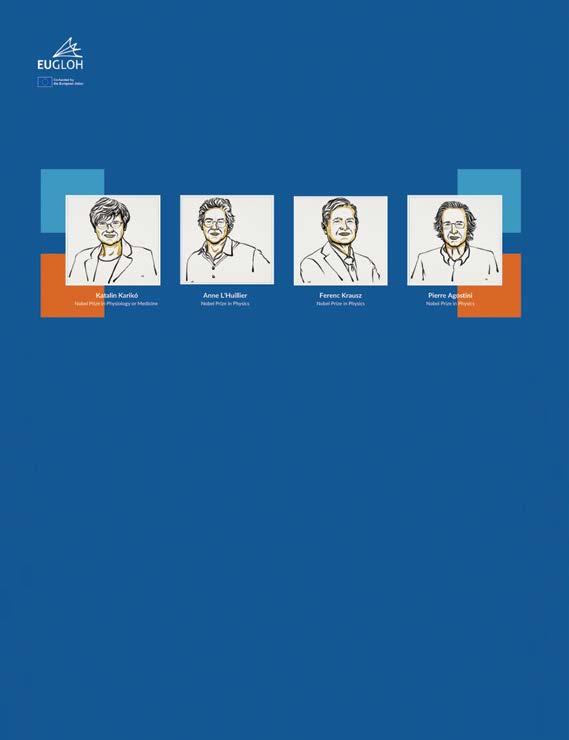
Katalin Karikó, who received a shared Nobel Prize in Physiology or Medicine 2023, obtained her diploma at the University of Szeged (Hungary). After she completed her PhD started her research with mRNA in Szeged. After that, she continued her career in the United States and then in Germany. Since 2021, she has been a research professor at the University of Szeged.
Among the three researchers who shared the Nobel Prize in Physics 2023, Anne L’Huillier is currently a professor of atomic physics at Lund University (Sweden). She is also a member of the Governing Board at the Institut d’Optique Graduate School at Université Paris-Saclay (France). From 1982 to 1995, L’Huillier was a researcher at the Service for the Physics of Atoms and Surfaces (now LIDYL) at CEA Saclay. In addition, L’Huillier works closely with the Faculty of Natural Sciences of the University of Porto, where she contributes directly to the development of the local entrepreneurial ecosystem.
Ferenc Krausz is the chair of the Department of Experimental Physics/Laser Physics at Ludwig-Maximilians-Universität (Munich) and director of the Max Planck Institute of Quantum Optics, Garching (Germany).
Pierre Agostini was a researcher at LIDYL at CEA Saclay (currently within the Université Paris-Saclay) from 1968 to 2002 and is currently an emeritus professor at Ohio State University (USA).
The EUGLOH (European University Alliance for Global Health) alliance started its work in 2019 in cooperation with the French Paris-Saclay University (UPSaclay), the Swedish Lund University (LU), the German Ludwig Maximilian University of Munich (LMU), the Portuguese University of Porto (UPorto) and the Hungarian University of Szeged. From January 2023, four more universities joined the EUGLOH strategic partnership: the University of Alcalá (Spain), the University of Hamburg (Germany), the University of Novi Sad (Serbia), and UiT – the Arctic University of Norway (Norway).
Each university is proud of the excellence associated with the institution - as an
alumnus, current, or former professor. Five universities in the EUGLOH association are home to Nobel laureates. In 2023, LUND UNIVERSITY entered the list of Nobel Prize-winning universities when the institution’s professor, Anne Geneviève L’Huillier, together with Ferenc Krausz (Ludwig Maximilian University of Munich) and Pierre Agostini (Ohio State University, USA), won the prestigious award in Physics. The Nobel laureate in Physics of the PARIS-SACLAY UNIVERSITY is Alain Aspect (2022), jointly with John Clauser and Anton Zeilinger.
The Nobel Prize winners in Physiology or Medicine of the UNIVERSITY OF SZEGED are Albert Szent-Györgyi (1937) and Kata-
lin Karikó, the latter received the most famous award in the scientific world jointly with Drew Weissman (2023). The strength of the UNIVERSITY OF HAMBURG lies in Physics since Klaus Hasselmann (2021) won the Nobel Prize in this field – together with Syukuro Manabe and Giorgio Parisi – just like Wolfgang Ernst Pauli (1945) and Otto Stern (1943). In addition, J. Hans D. Jensen received the Nobel Prize in Physiology or Medicine (1963).
The LUDWIG MAXIMILIAN UNIVERSITY OF MUNICH is home to 15 Nobel laureates. The Nobel Prize winners in Chemistry are: Gerhard Ertl (2007), Ernst Otto Fischer (1973), Adolf Butenandt (1939), Heinrich Wieland (1927), Richard Will -
statter (1915), Adolf von Baeyer (1905). Karl Ritter von Frisch (1973) received the Nobel Prize in Physiology or Medicine just like Feodor Lynen (1964). The latest awardee is Ferenc Krausz, who received the Nobel Prize in 2023 together with two other researchers in the field of Physics. Previously, Theodor W. Hänsch (2005) won recognition in this field together with John L. Hall and Roy J. Glauber; as well as Gerd Binnig (1986), who won the award together with Heinrich Rohrer; the list can be extended further with Werner Heisenberg (1932), Max von Laue (1914), Wilhelm Wien (1911) and Wilhelm Conrad Röntgen (1901), the first scientist to win the Nobel Prize in Physics.
How is attosecond physics related to Szeged? Physicist Dr. Katalin Varjú, associate professor of the SZTE Institute of Physics, became acquainted with attophysics years ago as a colleague of Nobel laureate Anne L’Huillier, and today she is the scientific director of ELI ALPS in Szeged.
– How did you get involved with attophysics?
– After obtaining my doctorate, I learned about the science of high-intensity ultrashort laser pulses in the TeWaTi (TeraWatt Titanium-Sapphire laser research group) laboratory at the Department of Optics and Quantum Electronics at the University of Szeged. At this time, I came across that Anne L’Huillier was looking for a postdoctoral fellow at Lund University. I applied for this position and Anne offered me a job. It was at Lund University that I learned about attosecond physics. This was a wonderful time for me, I learned a lot and the environment was motivating. After returning home, I planned to carry out further research in this field of science.
– What experiences did you gain as a colleague of Anne L’Huillier?
– I worked with Anne L’Huillier for two and a half years as a postdoctoral fellow at Lund University, but our scientific cooperation has been continuous ever since. One of the attosecond beamlines of ELI ALPS was designed by her group, which gave new impetus to the joint experiments. Anne is a highly motivated researcher. Her exceptional curiosity strives her to understand elementary processes, and this is combined with a high level of physics knowledge.
– How does ELI ALPS relate to attosecond physics?
– It is common that attosecond science also appears in a research infrastructure such as ELI, which has set the goal of developing and applying high-intensity lasers. In the three existing ELI institutes, in Szeged, Prague, and Bucharest, the fields of application of high-intensity lasers are slightly different. The letter ‘A’ in ALPS, or Attosecond Light Pulse Source, denotes the Szeged institute’s expertise in attosecond pulses.
– In which tests and fields of science does ELI ALPS use the attosecond technique for?
– Attosecond science includes two groups of experiments. In one case, we examine the creation of the attosecond pulses themselves, since we can observe properties referring to the material itself in the harmonic radiation produced here, as a result of the intense laser’s interaction with the material. The other group is the experiment where the created attosecond pulse is used in some pump-probe arrangement to investigate electron dynamics. Attosecond pulses’ primary benefit is that their short duration allows for the investigation of very fast processes. On such a time scale, we can study the behavior of electrons.
 dr. Bettina TÓTH
dr. Bettina TÓTH
ELI ALPS

Two iconic memorial sites, the Promenade of Scientists, located in Szeged, and the Trail of Women Scientists, in Újszeged, draw attention to the achievements of the most outstanding researchers who enriched knowledge at the University of Szeged
Walking on the PROMENADE OF SCIENTISTS - from the Rector’s Office on Dugonics Square in Szeged towards the roundabout on Tisza Lajos Boulevard (Somogyi Street side) - the names of fourteen world-renowned researchers and lecturers of the University of Szeged, who have achieved outstanding scientific results, can be read on the 14 stone spheres placed next to the tree line.
The name of the Nobel Prize-winning physician and biochemist Albert Szent-Györgyi (1893-1986), on the stone sphere closest to the university building on Dugonics Square, reminds us of his discoveries regarding the role of vitamin C and fumaric acid catalysis. Besides the greats of the Szeged school of mathematics László Kalmár (1905-1976), Béla Szőkefalvi-Nagy (1913-1998), and Frigyes Riesz (1880-1956), the name of zoologist Ambrus Ábrahám (1893-1989), physicist Ágoston Budó (1914-1969), biochemist Brunó F. Straub (1914-1996), ethnographer Sándor Bálint (19041980), pharmacologist Miklós Gidófalvi Jancsó (1903-1966), mineralogist Sándor Koch (1896-1983), jurist István Kovács (1921-1990), internist Géza Hetényi (1894-1959) and historians Gyula Kristó (1939-2004) and Tibor Wittman (19231972) are engraved in stone, so that the city and the university pay tribute to their greatness.
The 30-centimeter-diameter limestone ornaments lining the Promenade of Scientists were created by sculptor Gábor Székó in 2012.
On February 12, on Darwin Day, the international day of scientific thinking, the Botanical Garden of University of Szeged announced that it would create and continuously expand the TRAIL OF WOMEN SCIENTISTS on the initiative and support of the Szeged women’s charity Partiscum Club.
The project will be launched on April 17, 2024, in the presence of Katalin Karikó (1955 – ) – the Nobel Prize-winning biologist and biochemist who founded the development of the medical technology of synthetic mRNA vaccines with her discoveries – with the
presentation of an installation paying tribute to her achievements. Next to her, women scientists connected to the University of Szeged will receive memorials, such as biochemist Ilona Banga (1906-1998), botanist Vera Csapody (1890-1985), pharmacist Aranka Gábor (1922-1981), painter and graphic artist Márta Kopasz (1911-2011), historian Mária Ormos (1930-2019), and doctor and biochemist Mária Wollemann (1923-2019).
In the Hortus Botanicus in Újszeged, in the area of the historical rose collection, ceramic installations inspired by plants, by artist Eszter Anita Szűcs, mark the Trail of Women Scientists.
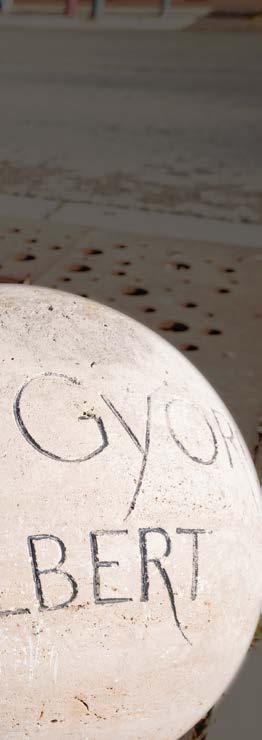
The University of Szeged contributes to the popularization of science and research with traditional and innovative forms of education.
The traditional interpretation of scientific education is to explain in simple and understandable way a discipline’s perspective on certain topics. The university exiled from Cluj and welcomed in Szeged, has a traditional educational forum in the form of its Free University lecture series. The SZTE Free University and the SZTE BTK Free University in Humanities, the Researcher’s Night, and the lecture series of the Hungarian Science Festival revive the traditions of the general literacy course. Articles and interviews published as the product of scientific journalism are the conventional means of interpreting scientists’research results and explaining their findings in a comprehensible way to the general public. Such compilations, enriched with photos, can be read in various publications of the University of Szeged, such as the University of Szeged Magazine, the Heureka magazine, and the SZTE website.
The University of Szeged has established dozens of academic competitions with the aim of enhancing students’ motivation for higher education and complementing the secondary school curriculum. The SZTE Szent-Györgyi Academic Competition stands out among them all, as it blends creative work with an understanding of multiple natural science disciplines. The student competition, was first announced in 2012, on the 75th anniversary of Albert Szent-Györgyi’s Nobel Prize, also aims to promote awareness about the work of researchers who won the top prize in science.
The virtual exhibition „Katalin Karikó - former excellent student of the University of Szeged, honorary doctor of SZTE, professor of SZTE” is available online. Readers from all over the world can learn from reliable sources in Hungarian, English, German and French about the life journey of the internationally recognized biochemist, her studies in Szeged and the research work leading to the Nobel Prize through the discovery of the mRNA vaccine and therapy. More information is available on the website of the SZTE Klebelsberg Library, where additional virtual exhibitions highlight 11 aspects of SZTE’s rich scientific history: https://mediateka.ek.szte. hu/exhibits
The University of Szeged presents a travelling exhibition of documents about Katalin Karikó’s life journey, the most interesting of her over a hundred awards, as well as press and art photographs from the award ceremonies. In 2023, the travelling exhibition was presented in Szeged, Kisújszállás, Zánka, Salgótarján, Balassagyarmat, Gyula, Budapest, Veszprém and Pécs. The exhibition series will continue in 2024, while SZTE will present the life journey and awards of research professor Katalin Karikó in a permanent exhibition, including an authentic copy of her Nobel Prize.
More information about Katalin Karikó is available on the SZTE website: https://u-szeged.hu/karikokatalin/en
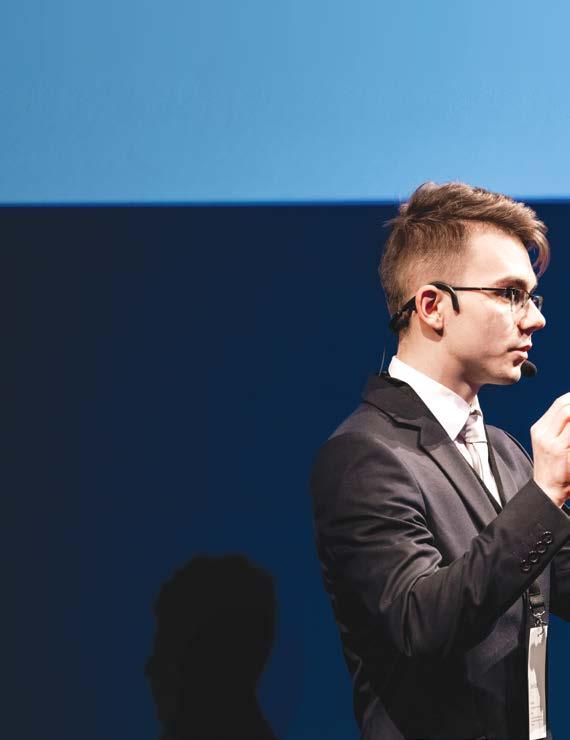
Even as a high school student, Dániel Viczián accumulated outstanding results and shiny medals in various academic competitions. The first-year chemistry student of SZTE was able to participate in the Nobel Week programs in Stockholm, where he popularized the science of chemistry. Recently, he won a one-year Prime Minister’s scholarship.
The young scientist Dániel Viczián, a first-year chemistry student at SZTE, could be an active participant in the programs of the 2023 Nobel Week in Stockholm. The “Stockholm International Youth Science Seminar” was part of the series of events of the Nobel Week in Sweden, where the Szeged student popularized the science of chemistry.
Since 2001, the Hungarian Association for Innovation (MISZ) has been able to delegate a young Hungarian researcher every year to the Nobel Prize ceremony and the one-week scientific forum in Stockholm.
Dániel Viczián won the opportunity to participate in the Nobel Week in the Association’s 2023 application. A maximum of 25 young people from different countries of the world can qualify. 18 young researchers from 13 countries took part in the event between December 4 and 11, 2023.
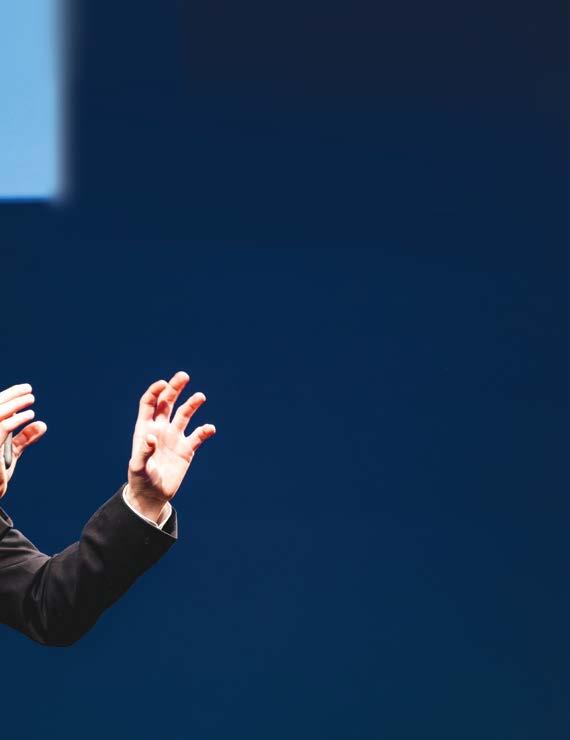
AMONG WORLD-RENOWNED SCIENTISTS
Dániel Viczián received great applause on the stage of the 42nd “Stockholm International Youth Science Seminar”, i.e. SIYSS, with his presentation entitled “Multifunctional nanocomposites: synthesis and antioxidant activity assessment in colloidal dispersions”.
Dániel Viczián was able to meet several times with Nobel laureates, including the two Hungarian laureates. On October 12, 2023, during Katalin Karikó’s visit to Szeged, he had the opportunity to meet the Nobel Prize-winning scientist and ask questions as one of the moderators of the student seminar.
– I often received questions like, “Have you met them?”, “What are they like?” I told them that when Katalin Karikó visited the University of Szeged, thousands of people could see and experience that she is a very direct person. She is enthusiastic and, in my experience, likes to talk to interested young people. I highlighted that it’s definitely worth talking to her. I found Ferenc Krausz to be a surprisingly similar researcher. I met him at the Hungarian Embassy in Stockholm. He is a nice, open person. It didn’t even look like he was tired of the enormous number of questions and joint photo requests that he had to deal with during Nobel Week in Stockholm – Dániel Viczián summarized his experiences.
SILVER MEDAL FROM ZURICH AND ASTANA
The young man proved his knowledge and talent several times as a student of the Radnóti Miklós Experimental High School in Szeged. For example, he finished the 55th International Chemistry Olympiad in Zurich with a silver medal in 2023. As a reward for this, he received a Prime Minister’s scholarship, which includes HUF 35,000 per month for 12 months.
He brought home the silver medal of the IMChO – considered the most difficult chemistry competition – from the capital of Kazakhstan, Astana. It can be read on the website of the Radnóti High School that 21 countries were represented by 120 competitors at the 57th Mendeleev Chemistry Olympiad. Not mentioning the matriculation exams in May 2023, in which Dániel Viczián also excelled, and that he received a grand prize in the chemistry section for his presentation entitled “Production of composites based on manganese dioxide nanoparticles and investigation of their antioxidant effect” at the 23rd Carpathian Basin Conference of Scientific Students’ Associations.
The high school student majoring in mathematics and physics not only polished his thinking and refined his vision with academic competitions, but he also dealt more and more with physical chemistry and materials science.
IT’S NEVER TOO EARLY TO START RESEARCHING
– Teacher Ádám Szivós drew my attention to the possibility that high school students can also do research. The teacher was already an SZTE ambassador, and he received this title again from the University of Szeged. Through the Internet, on the websites of SZTE, I chose a group that dealt with things that I did not fully understand yet, but I saw potential in the topics – Dániel Viczián explained how he came across the MTA-SZTE “Lendület” Biocolloids Research Group. He spent a year and a half at the Institute of Chemistry of the SZTE Faculty of Science and Informatics, in the Department of Chemistry and Materials Science, under the supervision of associate Professor István Szilágyi.
– The antioxidant effect is the ability of substances to break down reactive particles. Nature and almost all living organisms use enzymes that can exert this antioxidant effect. However, if we want to use them in practice, we will encounter disadvantages – the young scientist highlighted the interesting aspects of his research topic. – For example: these materials are very expensive, their storage is difficult, and they can lose their activity even due to small changes in environmental conditions.
“Let children close to natural sciences!” – is Katalin Karikó’s message. As a result, a study trip to the researcher’s Alma Mater in Szeged was organized by the specialist teachers from her high school in Kisújszállás. We accompany them in our report to attract the curiosity of others in the science tour of the University of Szeged.
On the science tour organized for the students of the Móricz Zsigmond Reformed Secondary and Grammar School, Dr. Katalin Siposné Musza conducted empirical experiments in the red student lab at the Institute of Chemistry of the University of Szeged. Buzzing sounded around the room, and occasionally an impressed voice would announce that the experiment had gone well.
The students visited the student and research laboratories at the Institute of Chemistry of the University of Szeged, they were clearly impressed by the color-coded labs, and the fact that the doors to the student cabinets in the organic lab are not numbered, but rather marked with successive formulas of saturated hydrocarbons.
The Dóm Square building preserves the noblest traditions of researchers of the University of Szeged: the mezzanine lecture hall is the same one where students awaited Albert Szent-Györgyi in the fall of 1937 with a table full of flowers, and a balcony opens from the white lab, from which Albert Szent-Györgyi and then Katalin Karikó greeted those gathered on the news of the Nobel Prize.
The afternoon was spent at the ELI ALPS Laser Research Centre, where Vera Zimányiné Horváth awaited the students. Prior to the visit to ELI ALPS the students’ knowledge about laser extended only to lightsabers, but as they departed, they learned
about the science model of the first laser facility in history.
The following day, the students’ first excursion led to the Albert Szent-Györgyi Memorial Room. They discovered the archival photographs showing the Nobel laureate Albert Szent-Györgyi sitting in the study at Dóm Square, which is currently Katalin Karikó’s „workplace” in Szeged.
Director, Anikó Németh greeted the students in the Botanical Garden of the University of Szeged; here they found out that elementary school student Katalin Karikó was also enchanted by the world of plants. She enrolled at the József Attila University as an enthusiast of botany, it happened here that she initially heard about the amazing molecule, leading to her international recognition as an mRNA researcher. Environmental educator Lajos Balogh-Langer guided the students through the Botanical Garden, which was founded in 1922 as a sister institution to the Botanical Garden in Cluj by István Györffy – professor of botany at the time –for the training of university students majoring in biology.
– Tamás Szabó, deputy director of the Móricz Zsigmond Reformed Secondary and Grammar School in Kisújszállás noted that the study trip was already successful if we can make one or two students interested in studying biology, chemistry, or physics.


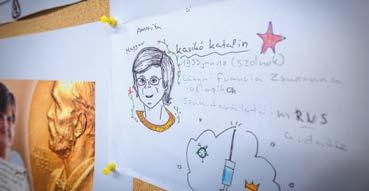
The University of Szeged popularized science through informative lectures, unique classes, competitions, and creative contests. The programme series, known as the “Nobel Weeks at the University of Szeged”, primarily targeted high school and university students.
“It’s cool to be a researcher today! Science is fancy! Following in the footsteps of Katalin Karikó and Ferenc Krausz, two Hungarian Nobel Prize-winning researchers, the colorful world of science opens up.” – Students were the target audience for the “Nobel Weeks at the University of Szeged” awareness campaign. The programme series, aimed at popularizing science, began on November 22, 2023, when Katalin Karikó answered the questions of Szeged students in a video call at a joint round table discussion organized by SZTE and the Mathias Corvinus Collegium.
A number of particular classes focused on Nobel laureates and related topics in Kisújszállás, Szeged, and Veszprém. For example, at the Lovassy László High School in Veszprém, Tünde Praznovszky, an alumna of the institution and the University of Szeged, candidate of science in biology held a special lecture. Students had the opportunity to learn about Katalin Karikó, Ferenc Krausz, and former Hungarian Nobel laureates in the unique biology class that was held at the SZTE Juhász Gyula Primary School on December 7, 2023.
At the “Nobel Weeks at the University of Szeged” campaign on December 10, 2023 we jointly celebrated the Nobel Prizes of Katalin Karikó in Physiology or Medicine and Ferenc Krausz in Physics at JATE Club. The competitions related to the celebration also focused on science and creativity. During the competition, the participants watched together the live broadcast of the Nobel Prize ceremony in Stockholm. Szeged talent management organizations (Csányi Foundation Szeged, SZTE Junior Academy, Mathias Corvinus Collegium), SZTE training schools, and interested students from other institutions joined the programme series.
In the presence of Katalin Karikó, between April 16-17, 2024, the “Nobel Weeks at the University of Szeged” programme series reached a new peak. The research professor from the University of Szeged brought her Nobel Prize to display and presented an authentic replica of it to SZTE during an honorary ceremony. The winners of the high school idea competition and creative (poem, poster, TikTok video) contests for students were announced.


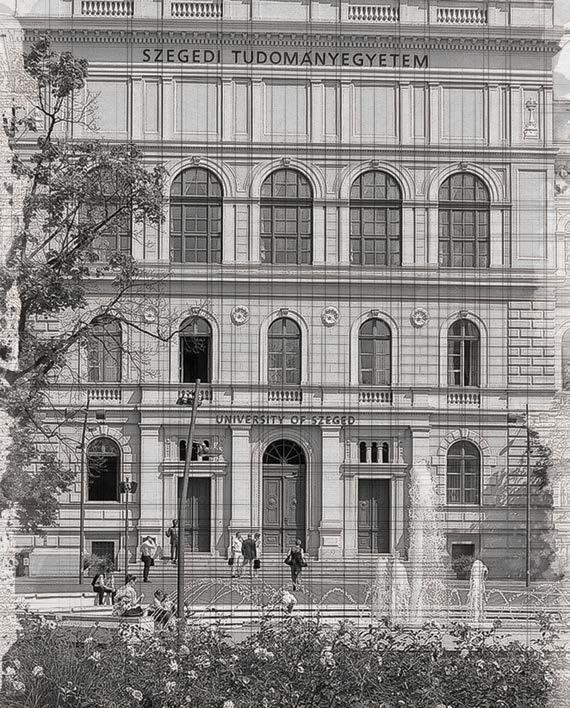

 UNIVERSITY OF SZEGED Szegedi Egyetem Magazine 2024
UNIVERSITY OF SZEGED Szegedi Egyetem Magazine 2024